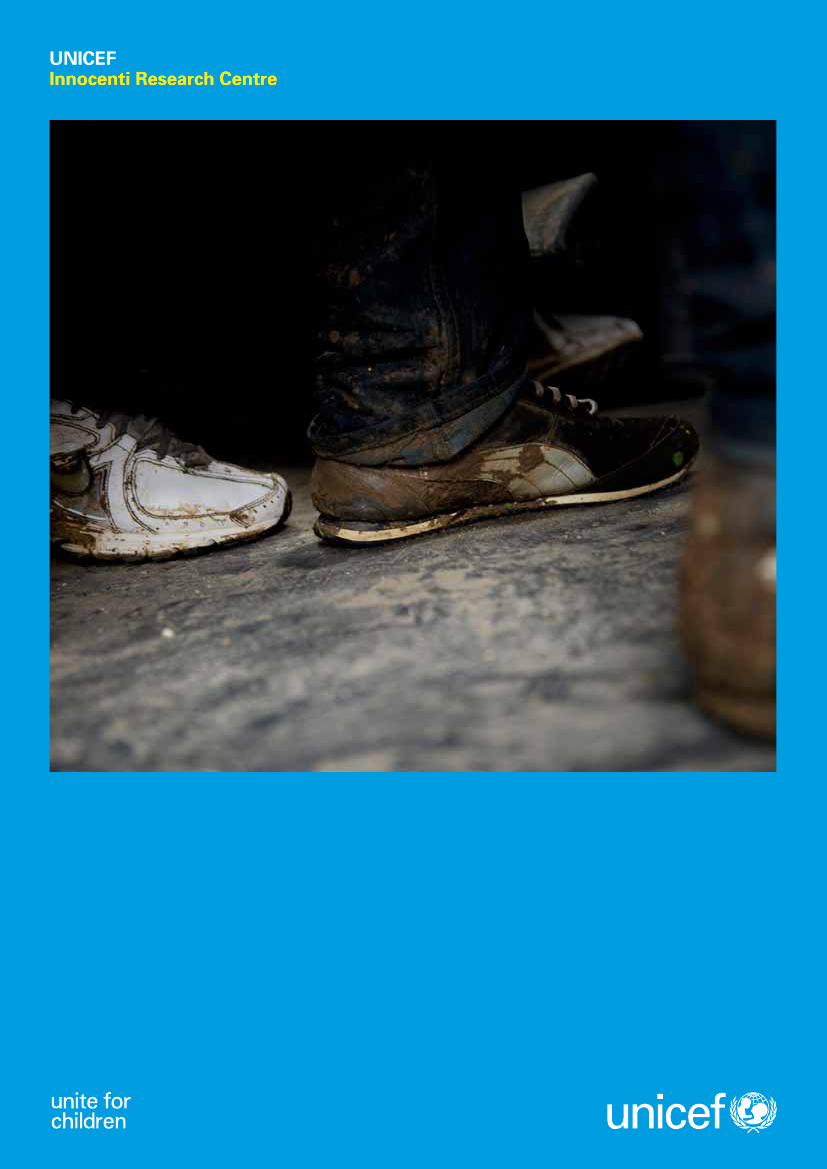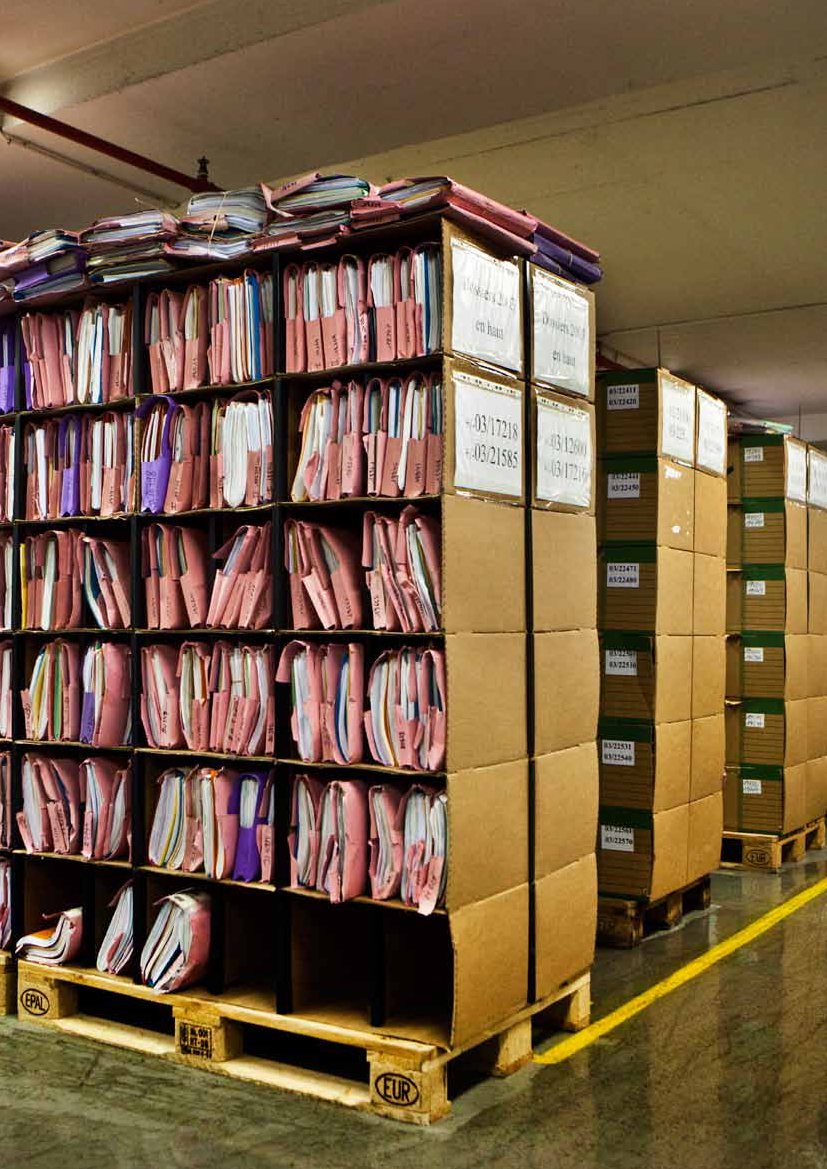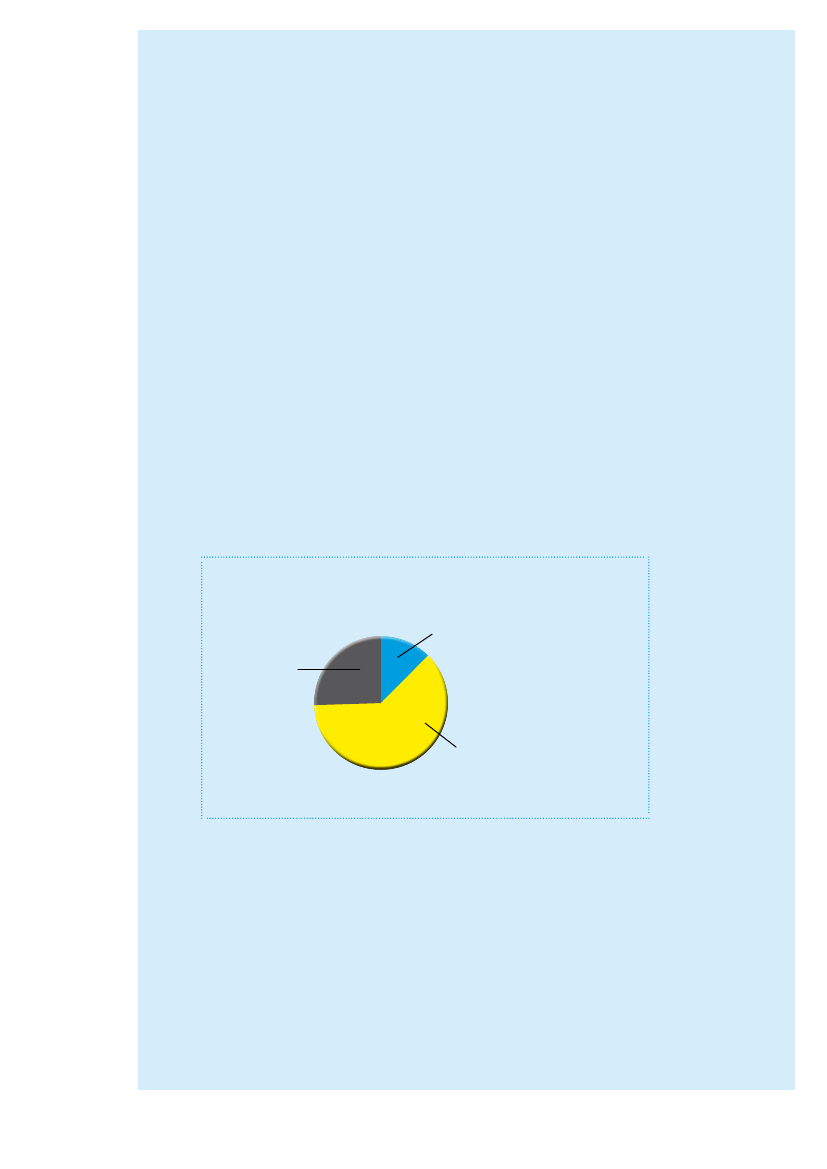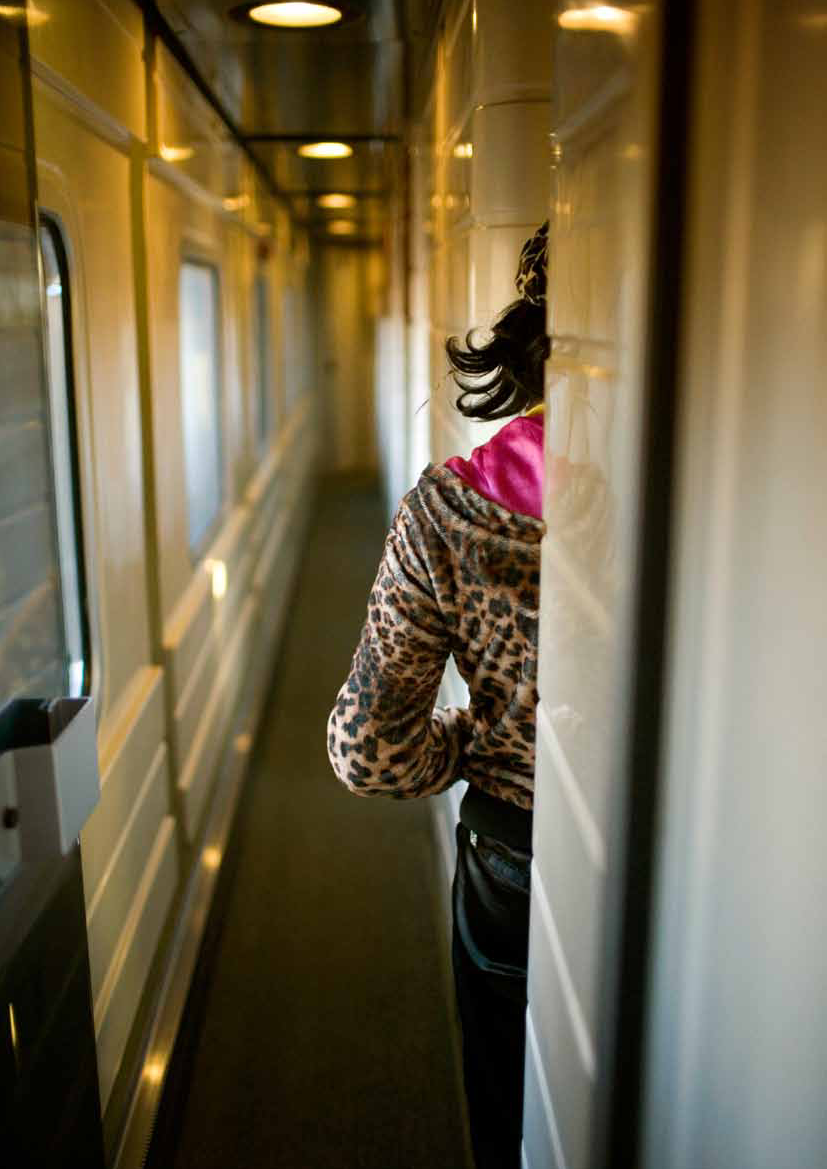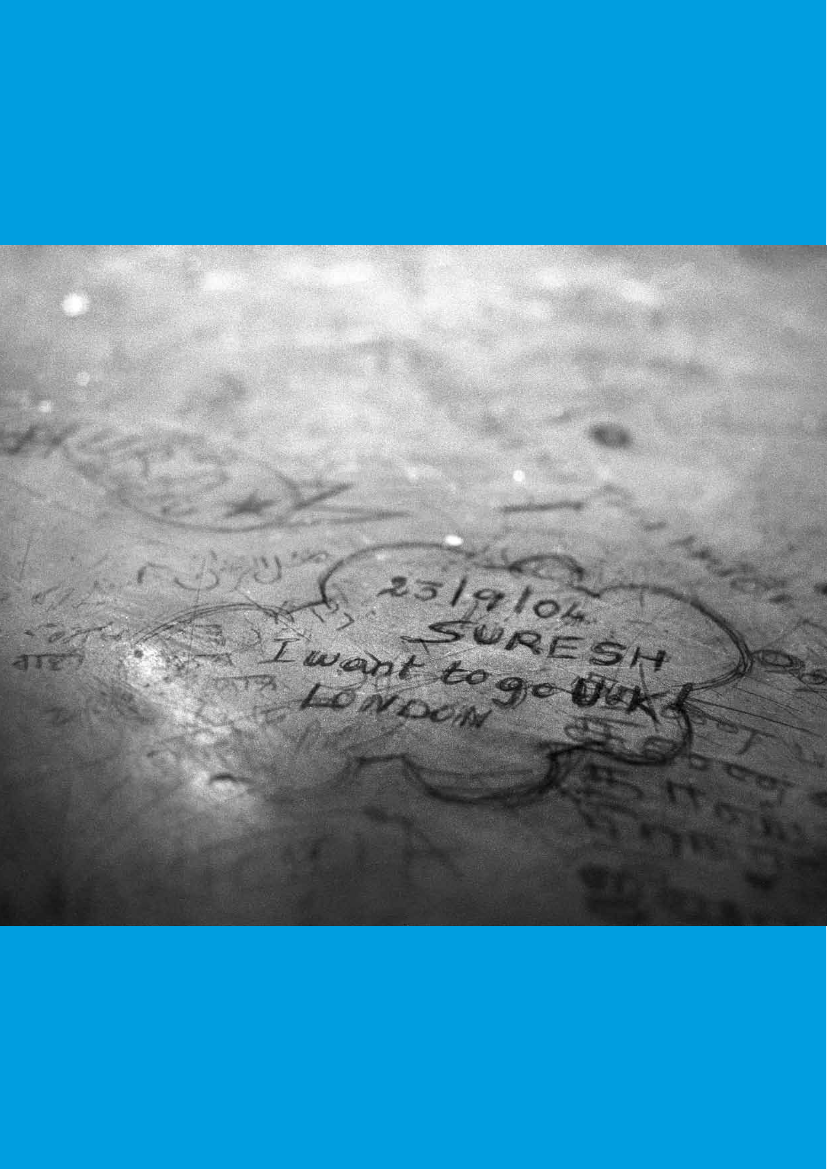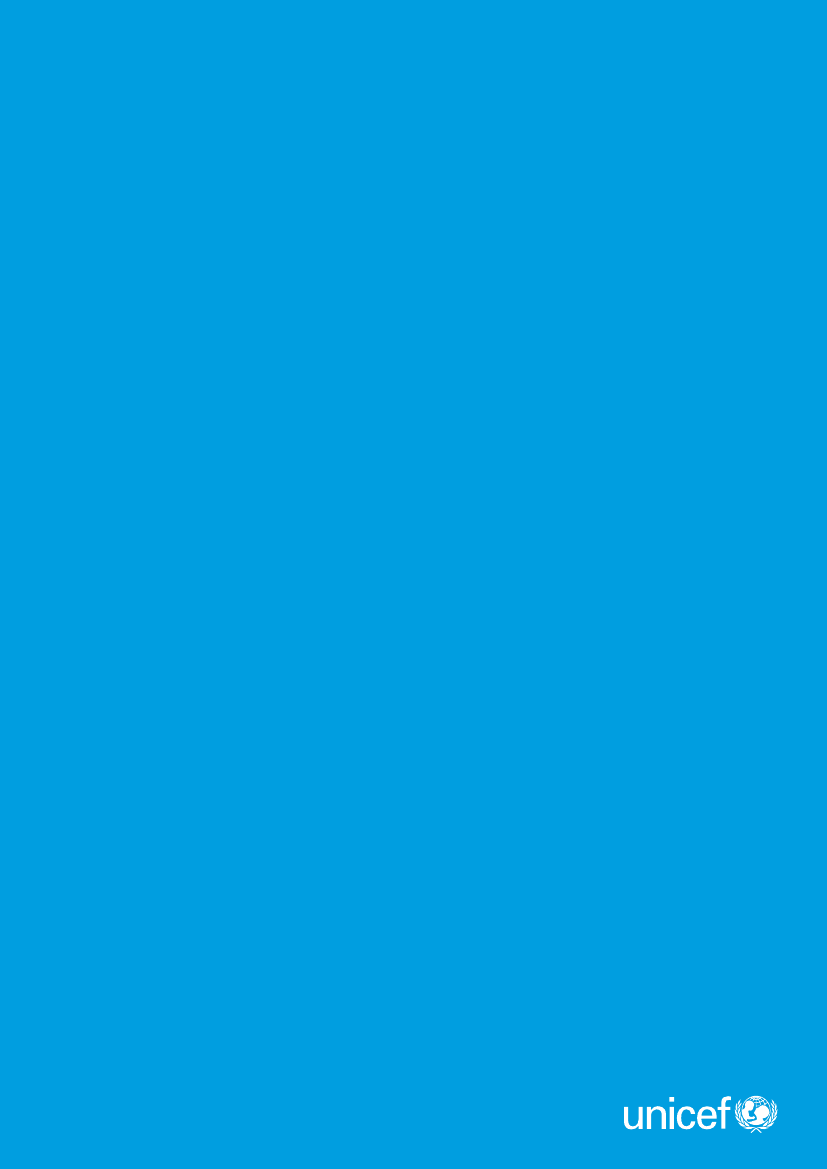Socialudvalget 2011-12, Ligestillingsudvalget 2011-12, Beskæftigelsesudvalget 2011-12, Retsudvalget 2011-12, Udvalget for Udlændinge- og Integrationspolitik 2011-12
SOU Alm.del Bilag 173, LIU Alm.del Bilag 33, BEU Alm.del Bilag 86, REU Alm.del Bilag 233, UUI Alm.del Bilag 71
Offentligt
Child Traffickingin the Nordic CountriesRethinking strategies andnational responses
Cover photo: Muddy feet of illegal immigrants who, after crossing the Turkish-Greek border,have been detained by officers of the European Union border police, Frontex.� Jeroen Oerlemans / Panos
Child Trafficking in the Nordic Countries:Rethinking strategies and national responses
Prepared by the UNICEF Innocenti Research Centrein collaboration with the National Committees for UNICEFin Denmark, Finland, Iceland, Norway and Sweden
The UNICEF Office of Research, Innocenti
The Innocenti Research Centre (IRC) was established in Florence, Italy in 1988 to strengthen theresearch capability of the United Nations Children’s Fund (UNICEF) and to support its advocacy forchildren worldwide. The Centre helps to identify and research current and future areas of UNICEF’swork. Its prime objectives are to improve international understanding of issues relating to children’srights and to help facilitate full implementation of the Convention on the Rights of the Child indeveloping, middle-income and industrialized countries.IRC is the dedicated research hub of the UNICEF Office of Research (OOR), which providesglobal leadership for the organization’s strategic research agenda around children. The Officeaims to set out a comprehensive framework for research and knowledge within the organization,in support of its global programmes and policies. Through strengthening research partnerships withleading academic institutions and development networks in both the North and South, the Officeseeks to leverage additional resources and influence in support of efforts towards policy reform infavour of children.IRC’s publications are contributions to a global debate on children and child rights issues andinclude a wide range of opinions. For that reason, the Centre may produce publications that do notnecessarily reflect UNICEF policies or approaches on some topics. The views expressed are thoseof the authors and/or editors and are published by the Centre in order to stimulate further dialogueon child rights.The Centre collaborates with its host institution in Florence, the Istituto degli Innocenti, in selectedareas of work. Core funding for the Centre is provided by the Government of Italy, while financialsupport for specific projects is also provided by other governments, international institutions andprivate sources, including UNICEF National Committees.Design and layout: TOMCOM, Konzeption und Gestaltung, Postdam, Germany� United Nations Children’s Fund (UNICEF)December 2011ISBN: 978-88-6522-003-0Requests for permission to reproduce or translate UNICEF IRC publications should be addressedto: Communications Unit, UNICEF Innocenti Research Centre, [email protected].Correspondence should be addressed to:UNICEF Innocenti Research CentrePiazza SS. Annunziata, 1250122 Florence, ItalyTel: (39) 055 20 330Fax: (39) 055 2033 330[email protected]www.unicef-irc.org
ii
Acknowledgements
This publication was coordinated by the UNICEF Office of Research, Innocenti, assisted by aninternational panel of advisers and reviewers. The research was conducted in close collaborationand consultation with the National Committees for UNICEF in Denmark, Finland, Iceland, Norwayand Sweden, which also kindly provided financial contributions for this study.ResearchersDaja Wenke, Principal Researcher, Independent ConsultantPhil Marshall, Writer and Editor, Director, Research Communications Group, New ZealandSusanna Nordh, Research Assistant, UNICEF Office of Research, InnocentiDanish Committee for UNICEFAnne-Mette Friis, Head of Education for DevelopmentKarin Aaen, Director of Communication and AdvocacyJakob Colville-Ebeling, Communication and Advocacy OfficerFinnish Committee for UNICEFInka Hetemäki, Programme DirectorTanja Suvilaakso, Child Rights AdvisorSara Park, former Advisor, Advocacy and CommunicationJohanna Kurki, Advocacy Manager, Domestic Child PolicyIcelandic National Committee for UNICEFBergsteinn Jónsson, Project Coordinator for Education and YouthLóa Magnúsdóttir, Fundraising and AdvocacyNorwegian Committee for UNICEFNina Kolbjørnsen, Project ManagerAnita Daae, Head of CommunicationSwedish Committee for UNICEFChristina Heilborn, Advocacy DirectorUNICEF Office of Research, InnocentiGordon Alexander, DirectorJasmina Byrne, Child Protection SpecialistAndrew Mawson, Chief of Child ProtectionClaire Akehurst, Executive AssistantAesa Pighini, ConsultantUNICEF technical support/adviceJyothi Kanics, Advocacy and Policy Specialist, UNICEF GenevaSusu Thatun, Child Protection Specialist, UNICEF New YorkKarin Heissler, Child Protection Specialist, Planning and Evidence-Building, UNICEF New YorkMargaret Wachenfeld, Senior Policy Adviser, UNICEF BrusselsYu Kojima, International Consultant and former Child Protection Specialist,UNICEF Office of Research, InnocentiExternal advisers/peer reviewersLena Karlsson, Director, Child Protection Initiative, Save the ChildrenLars Lööf, Head of the Children‘s Unit, Council of the Baltic Sea StatesJulia O’Connell Davidson, Professor of Sociology, School of Sociology and Social Policy,University of NottinghamMike Dottridge, International ConsultantMaria Indiana Alte, Project Coordinator, Counter Trafficking Unaccompanied Minors,International Organization for MigrationHanne Mainz, Social Consultant, Danish Centre against Human TraffickingVenla Roth, Senior Officer, Office of the Ombudsman for Minorities, NationalRapporteur on Trafficking in Human Beings, Finland
iii
Stacks of folders containing applications for asylum in the Office of the CommissionerGeneral for Refugees and Stateless Persons in Brussels.� Dieter Telemans / Panos
Contents
AcknowledgementsForewordIntroductionAbout the StudyKey Concepts: Child protection and best interestsPart I:The Convention on the Rights of the Child as a framework for protectionThe definition of traffickingDifficulties in identifying trafficked childrenTrafficking in the Nordic countriesOther risks faced by vulnerable migrant childrenProvision of services based on identification as a victim of traffickingMoving beyond the trafficking frameworkSafeguarding children through the ConventionPart II:Responses of the Nordic Countries to child traffickingOverall response to child traffickingBroader child protection responsesExpanding services from identified trafficking victims to ‘potential victims’Part III:Guiding principles of the Convenion of the Rights of the ChildGuiding principlesThe right to non-discriminationThe best interests of the childThe right of the child to have his or her views heard and taken into accountChild-sensitive complaint mechanismsThe right of the child to life, survival and developmentPart IV:Vulnerable migrant children and legal, judicial andadministrative processesNon-punishmentDeprivation of libertyIssues relating to return of children to their home countriesTransfers under the ‘Dublin II Regulation’Part V:Promising interventionsConclusions and recommendationsConclusionsRecommendationsCountry-specific recommendationsAcronymsNotes
iiivi1335578899101111121315151516181919232324242529313132353839v
Regularization of stay: Reflection periods, temporary residence permits and asylum26
Foreword
This study,Child Trafficking in the Nordic Countries: Rethinking strategies and national responses,was initiated with twin aims: improving understanding of child trafficking and responses in the region;and contributing to the international discourse on child trafficking by examining the linkages betweenanti-trafficking responses and child protection systems. With these objectives in mind, in early 2010the UNICEF Innocenti Research Centre and the National Committees for UNICEF in Denmark,Finland, Iceland, Norway and Sweden set out to gather data and information. Two years later, followingan intensive period of literature review, interviews, round-table discussions, analysis and peer review,the final product has brought us further than we originally anticipated.Although the study was conceived with a primary focus on trafficking, its scope is much broader.It analyses how the general principles of the Convention of the Rights of the Child are applied inrelation to those children vulnerable to trafficking and other forms of exploitation. By examiningchild trafficking responses from a child rights perspective, the study was able to identify effectiveresponses as well as gaps in policy and practice. These related not only to children vulnerable tochild trafficking specifically, but to all migrant children at risk of exploitation.The study confirms that the Nordic countries have indeed made significant – and continuouslyevolving – attempts to address the issue of child trafficking, including through setting up relevantinstitutions, developing action plans and allocating budgets. However, while this has meant thatspecialized expertise is available for specific groups of children, it has sometimes led to fragmentationof services, leaving some children unprotected.The research also finds that many existing gaps may be bridged by consistent and strengthenedimplementation of the Convention on the Rights of the Child. This simple message resonates all overthe world. The Convention has been in existence for more than 20 years, and its far-reaching andholistic nature provides a framework for addressing even the most serious crimes against children.One of the many advantages of addressing child exploitation within such a framework is thatservices available to exploited and at-risk children need not depend on their identification as victimsof trafficking. This is particularly important in light of the study’s finding that there is little or noconsistency in the way the concept of trafficking is understood among stakeholders within the region.This in turn prohibits the fair and consistent application of the definition of trafficking to children.At the same time, the study highlights that there is a way to achieve a fuller realization of rights forchildren who are vulnerable in the context of migration. In particular, we still need to improve ourunderstanding of how to interpret and apply the concept of a child’s ‘best interests’; we need to learnhow to strengthen our ability and determination to seek and listen to the views of the child, includingallowing them to express concerns or complaints; and we need to put a stop to discrimination basedon factors such as a child’s nationality, status or citizenship, so that no child is left without theprotection or services that he or she is entitled to. For, irrespective of status or administrative category,a child is first and foremost a child.
Gordon AlexanderDirectorUNICEF Office of Research, Innocenti
vi
Introduction
It has now been 11 years since the adoption of the Protocol to Prevent, Suppress and PunishTrafficking in Persons, Especially Women and Children, supplementing the United Nations Conventionagainst Transnational Organized Crime (‘UN Trafficking Protocol’). This period has been marked bya major increase in international attention to trafficking, the adoption of new international guidelines,and the implementation of multiple initiatives aimed at preventing trafficking in persons, identifyingand providing support for victims, and apprehending and prosecuting perpetrators of the crimeof trafficking.As yet, however, information on the issue remains limited. There is no consensus on the number ofpeople trafficked and scant evidence of success of these actions and initiatives, with few evaluationsof the outcomes and impact of trafficking programmes. From the information that is available, itis clear that there is usually no single factor that leads to a person being trafficked; children’svulnerability to trafficking is complex and multifaceted. Patterns in reported cases suggest thatchildren who have been trafficked have often had earlier exposure to domestic violence, social andeconomic marginalization, or exclusion and exploitative relationships. Structural issues, including aprecarious migration status, or patterns of discrimination against children on the grounds of theirgender, ethnic or national origin, and legal or other status, constitute additional risk factors that maycause, sustain or exacerbate a child’s vulnerability to exploitation.1In line with these findings on multiple causes of vulnerability, and also noting the difficulty ofapplying the definition of child trafficking to individual cases in a way that is both consistent andbeneficial to trafficked children, there has been a growing recognition among practitioners thatresponses to child trafficking might be more effective when embedded in comprehensive andsystemic approaches that are based on the rights of the child as afforded under internationalstandards.2One of the features of such approaches is that they seek to cater to children‘s individualneeds and rights, rather than on a ‘categorization’ of children according to a specific legal or otherstatus, such as ‘trafficked’ or ‘not trafficked’.It was against this background that the UNICEF Innocenti Research Centre (IRC), in partnershipwith the UNICEF National Committees in Denmark, Finland, Iceland, Norway and Sweden, initiateda study on child trafficking in the Nordic region in early 2010. Covering the five Nordic countries, thestudy aims to generate a better understanding of child trafficking and national responses to the issue,from a child rights perspective.Although primarily focused on child trafficking, the authors of this study sought at the outset tolocate their analysis within a discussion of child protection responses to other vulnerable migrantchildren in the Nordic countries. This decision has proved significant. As evidence was gathered,it became increasingly clear that child trafficking cannot be adequately addressed independentlyof other vulnerabilities faced by children, migrant children in particular. This leads to the core findingof the study: that the Convention on the Rights of the Child offers a stronger framework for the protec-tion of trafficked (and other exploited) children than the child trafficking framework. In line with thisfinding, the study goes considerably beyond identifying strengths and gaps in existing responsesto child trafficking. It examines the potential that strategies for implementation of the Conventionon the Rights of the Child hold for addressing child trafficking in a broader context, as well as for theprotection of those referred to in the report as vulnerable migrant children.The Convention offers a number of advantages over a narrow child trafficking focus, notably intranscending the challenges of how trafficking is defined, understood and applied in practice.It can also help ensure that services for exploited children are geared more to the nature of their
introduction
1
exploitation than to how they came to be in an exploitative situation, e.g. by ensuring that similarservices are available for child victims of sexual exploitation, whether or not they are identified ashaving been trafficked. Although the question of resource allocation was not specifically addressedin the study, a framework that safeguards the right of all exploited and abused children to specialprotection measures would appear to facilitate a more efficient use of resources, particularly where,as in the Nordic countries, the number of confirmed trafficking cases is low.At the same time, the child trafficking lens proves a useful one through which to identify both effectiveinitiatives and response gaps within existing child protection systems. Using trafficking as a startingpoint, the study has also been able to identify several areas in which the countries concernedmight do more to fulfil their commitments to child protection, as set out in the Convention on theRights of the Child.This report seeks to highlight the major themes and key points identified in the accompanying technicalstudy. It is divided into five main parts, followed by a section on conclusions and recommendations.Each part starts with a general finding, followed by additional specific findings, as appropriate.Part I of the report outlines the considerations involved in the core finding on the relative protectionmerits of the child trafficking framework and the Convention on the Rights of the Child. It examinesthe concept of trafficking in human beings and identifies variations in how this is understood in theNordic region, particularly in relation to children. It highlights difficulties in applying the traffickingdefinition in a consistent and equitable manner, and also questions the value of determining servicesfor children based on their categorization as trafficking victims or otherwise. Lastly, Part I coversemerging attempts to address the difficulties identified with the trafficking framework and brieflyintroduces the Convention as an alternative.The considerable action taken by the Nordic countries in addressing child trafficking and relatedissues is the focus of Part II. This includes legal reform, establishment of specialized institutions,cooperation and coordination mechanisms, and development of tools and measures for theidentification of adults and children who have been trafficked. It also encompasses a wide rangeof assistance measures for trafficked persons. These have gradually been extended to possibletrafficking victims and others who may be vulnerable through the introduction of the concept of‘potential victim of trafficking’.Part III examines responses to trafficking and related issues in the Nordic countries againstConvention on the Rights of the Child commitments, focusing on the four general principles ofthe Convention: best interests of the child; right to non-discrimination; right to participation; and right tolife, survival and development. Several potential gaps are identified in each area, many relating todifferential treatment of children based on nationality and/or legal or other status. The differencein guardianship arrangements for officially identified child trafficking victims and other vulnerablemigrant children is highlighted as an example. The importance of strengthening child complaintmechanisms across the region is also discussed.Part IV of the report outlines issues relating to vulnerable migrant children and the associated legal,judicial and administrative processes. These include the rights of children as victims of crime, theimportance of protection from prosecution for crimes committed as part of the trafficking process,and concerns identified with regard to the deprivation of liberty among child victims of traffickingand other non-national children. Part IV goes on to examine the question of return or transfer tocountries of origin and other countries, with particular reference to the ‘Dublin II Regulation’
2
child trafficking in the nordic countries
(Council Regulation (EC) No 343/2003 of 18 February 2003 establishing the criteria and mechanismsfor determining the Member State responsible for examining an asylum application lodged in oneof the Member States by a third-country national). The short and long-term alternatives to return,including asylum, are also addressed.The study found numerous examples of promising policies and interventions that are worthy ofwider consideration throughout the region and beyond. Brief information on selected interventions isincluded in Part V. Based on the issues raised, the study then concludes with recommendations forstrengthening systemic and rights-based approaches to prevent the exploitation of vulnerable migrantchildren, and to assist children who have already been exploited, including, but not restricted to,victims of trafficking.About the StudyThis study was based primarily on a comprehensive literature review, complemented by key informantinterviews and a consultative review process. Selected country examples were also documented.The research was guided by international standards, in particular the Convention on the Rights ofthe Child and the ‘UN Trafficking Protocol’, as well as regional standards, instruments and initia-tives developed within the Council of Europe (COE) and the European Union (EU). The study wasalso informed by the work of the Council of the Baltic Sea States (CBSS) and its Expert Groupfor Cooperation on Children at Risk, and the Separated Children in Europe Programme.The research was implemented in consultation with a steering committee, made up of the focal pointsfor this study from the National Committees for UNICEF in each of the five countries, and an advisorygroup. Members of the advisory group included representatives from the Centre on Migration, Policyand Society (COMPAS) at the University of Oxford; CBSS; Save the Children; School of Sociologyand Social Policy at the University of Nottingham; Child Rights Advocacy and Education Section,UNICEF Private Fundraising and Partnerships (PFP) Division, Child Protection Section, UNICEFNew York; and an independent expert. The preliminary findings and recommendations from the studywere presented at technical round-table discussions in four Nordic countries (excluding Iceland).During the meetings, initial results were shared with key informants and further input, commentsand clarifications solicited. Between May and June 2011, the study was also peer reviewed byexperts from each of the countries.Key Concepts: Child protection and best interestsIn this report, the term ‘child protection’ refers to the protection of children from all forms of violence,exploitation and abuse. UNICEF defines child protection as “preventing and responding to violence,exploitation and abuse against children – including commercial sexual exploitation, trafficking, childlabour and harmful traditional practices.”3International agencies such as UNICEF and Save theChildren are increasingly advocating the benefits of a holistic response to issues affecting children,rather than an issues-based approach that can lead to fragmentation of services. The ‘best interests ofthe child’ is a central and all-embracing principle under the Convention on the Rights of the Child.Article 3 of the Convention stipulates that “in all actions concerning children, whether undertakenby public or private social welfare institutions, courts of law, administrative authorities or legislativebodies, the best interests of the child shall be a primary consideration.”4The right to non-discrimination,survival and development, and respect for the child’s views are all considered relevant in theassessment and determination of the best interests of the child.5However, there are no internationalinstruments that specify how best interests considerations should be applied in practice. The guidingprinciple has been introduced into several sectoral laws, regulations and policy plans in the Nordiccountries. The application of this principle in practice is a core focus throughout this study.
introduction
3
A variety of passports used as props at the Medininkai Border Guard School in Lithuania, where students learn to distinguish betweenreal and fake passports. The students here will work along the border between Lithuania and Belarus.� Fredrik Naumann / Panos
Part I: The Convention on the Rights of the Childas a framework for protection
General finding 1: The Convention on the Rights of the Child offers a stronger framework forthe protection of trafficked (and other exploited) children than the child trafficking framework.Specific finding 1:Significant differences exist across and within Nordic countries as to howtrafficking is defined and understood.Specific finding 2:Some migrant children face risks and exploitative practices that are not adequatelycovered by the ‘trafficking’ / ‘non-trafficking’ distinction.Specific finding 3:The provision of services for children based on the categorization ‘trafficked’versus ‘not-trafficked’ may be neither feasible nor desirable.
The definition of traffickingAn internationally recognized definition of trafficking in persons is contained in the ‘UN TraffickingProtocol’, which states in article 3:(a)“Trafficking in persons” shall mean the recruitment, transportation, transfer, harbouringor receipt of persons, by means of the threat or use of force or other forms of coercion, ofabduction, of fraud, of deception, of the abuse of power or of a position of vulnerability or ofthe giving or receiving of payments or benefits to achieve the consent of a person havingcontrol over another person, for the purpose of exploitation. Exploitation shall include, at aminimum, the exploitation of the prostitution of others or other forms of sexual exploitation,forced labour or services, slavery or practices similar to slavery, servitude or the removalof organs;(b)The consent of a victim of trafficking in persons to the intended exploitation set forth insubparagraph (a) of this article shall be irrelevant where any of the means set forth insubparagraph (a) have been used;(c)The recruitment, transportation, transfer, harbouring or receipt of a child for the purpose ofexploitation shall be considered “trafficking in persons” even if this does not involve any of themeans set forth in subparagraph (a) of this article;(d)“Child” shall mean any person under eighteen years of age.6The Protocol supplements the United Nations Convention against Transnational Organized Crime,a criminal justice instrument. It has been extremely influential in raising the profile of traffickingand has stimulated a wide range of responses. Not surprisingly given its origins, the provisions ofthe Protocol are particularly relevant in relation to the apprehension and prosecution of criminalsinvolved in human trafficking. While in many jurisdictions most of the composite crimes involved intrafficking are already offences, the crime of trafficking allows targeting of the entire trafficking chain,across borders and jurisdictions where necessary.At the same time, however, there are major complications related to how the definition of traffickingis understood and applied to real situations (seeBox 1, page 6).One consequence is limitedeffectiveness as a protective instrument for those who are victims of, or vulnerable to, human trafficking.
part i:the convention on the rights of the child as a framework for protection
5
Box 1: Definitional and conceptual challenges related to traffickingThe Protocol to Prevent, Suppress and Punish Trafficking in Persons, Especially Woman andChildren, supplementing the United Nations Convention against Transnational Organized Crime(‘UN Trafficking Protocol‘) defines trafficking in adults as comprising at least one ‘act’ of recruitment,transfer, harbouring or receipt of persons, at least one illicit ‘means’ such as coercion, threat anduse of force, and a ‘purpose’ of exploitation. The definition of child trafficking is essentially derivedfrom the definition related to adults, modified to require only an act and an exploitative purpose,not an illicit means.There are, however, challenges related to applying this definition in practice. These include:1. The term ‘exploitation’ is not clearly defined in the ‘UN Trafficking’ Protocol or any otherinternational legal instrument. Further, the Protocol explicitly leaves it up to individual states todecide what constitutes ‘sexual exploitation’, increasing the likelihood of inconsistent definitionsbeing used across different jurisdictions. The term ‘trafficking victim’ is also not defined.2. There are differences in the way the definition is understood among policymakers andpractitioners. For example, as shown in Figure 1 below, the study did not find consensus onwhether trafficking requires a movement component. A significant proportion of officials andpractitioners view kidnapping for adoption as a form of trafficking.7Thetravaux preparatoires(official records of the negotiations) of the Protocol, however, state that only “where illegaladoption amounts to a practice similar to slavery…it will also fall within the scope of theProtocol”.8Figure 1Key informants’ responses to the question “Do you consider‘movement’ to be a part of the trafficking concept?”YES 5No clearresponse 10
NO 24N = 39
3. It is often difficult to consistently apply the trafficking definition to on-the-ground realitiesacross different organizations and states. Indeed, it seems logical that a victim supportagency, with the primary role of assisting those in need, would wish to apply a more generousdefinition of what constitutes a trafficking victim than a criminal justice agency, which ischarged with applying finite resources to the investigation and prosecution of criminal cases.Responding to child trafficking in the context of the protection framework provided by theConvention on the Rights of the Child has the major advantage of transcending thesedefinitional and conceptual difficulties. From a child protection perspective, the importanceof the trafficking definition can be greatly reduced by focusing on the needs and rights ofindividual children, independently of their status as a trafficking victim.
6
child trafficking in the nordic countries
Difficulties in identifying trafficked childrenIdentifying child victims of trafficking in the Nordic countries poses numerous challenges. Some arerelated to definitional issues, as noted above. While the ‘act’ of human trafficking, i.e. the “recruitment,transportation, transfer, harbouring or receipt of persons” is reflected in the relevant sections ofthe criminal codes of all five countries, differences occur in relation to what constitutes exploitativepurposes. In Denmark, Iceland and Norway, national law provides an exhaustive list. In Finland andSweden, the scope of exploitation is left open by the reference to “other demeaning circumstances” or“other (exploitative) activity”.9An exhaustive list is in effect more limited than the ‘minimum’ provisionof the ‘UN Trafficking Protocol’, since new and emerging forms of exploitation may not be covered.Although each country has an agency with specific responsibility for victim identification, the processoften involves many different agencies, which sometimes use different screening tools.10At present,the authorities responsible for victim identification may also not be in contact with all groups ofchildren affected by trafficking. National authorities report, for example, that it is difficult to reachand identify accompanied children who may have been trafficked, and that limited means exist toidentify children trafficked within the EU.11Even where authorities are in contact with trafficked children, they may not be identified as havingbeen trafficked. For example, the study highlighted that there is limited consideration of traffickingexperiences or risks for children transferred under the ‘Dublin II Regulation’, which regulates whichcountry is responsible for examining a person’s asylum application (seePart IV).In Finland andSweden, children may not be identified as victims of trafficking if their exploiters are charged witha crime other than trafficking, such as procurement.12Further, while under the definition of childtrafficking a child “cannot consent to being trafficked”, study respondents suggested that thisconcept has not yet been fully understood and applied in criminal proceedings.13Victims of trafficking are often perceived to undergo severe psychological distress but may notalways show signs of harm when in contact with the authorities or service providers. If signs ofdistress are absent, authorities may not recognize the child in question to be a victim of trafficking.Exploitative situations may cause severe psychological distress to some children, but may also beaccepted by others as a harsh reality of life and as the only way to earn an income in the absenceof safer or more viable alternatives.14Children may also resist being assigned the status of a victimof trafficking particularly when, as highlighted throughout this study, it may serve to limit their mobilityand freedom of choice. Some children who are exploited in illegal activities may not consider themsel-ves victims but simply children in trouble with the law.15Taken together, these factors suggest major difficulties in the fair and consistent application of thetrafficking definition as it relates to children. In terms of consistency at least, this appears to besupported by the differences in national statistics. Only two child victims of trafficking wereidentified in Denmark between 2006 and 2010,16while Norway, which uses the broader definitionof ‘potential victim’, found 217 potential cases of child trafficking in a shorter period, 2007–2009.17Itseems unlikely that this signifies a much greater trafficking problem in Norway than in Denmark.Certainly, policymakers and service providers in the Nordic countries recognize that children whoare victims of trafficking or vulnerable to trafficking and associated exploitation may somehow slipthrough the existing web of protection systems.
part i:the convention on the rights of the child as a framework for protection
7
Trafficking in the Nordic countriesAcross the Nordic region, the number of officially identified trafficking victims is low.18From existinginformation, it can be concluded that adults and children are trafficked to and within the region andthey experience different forms of exploitation. Sexual exploitation takes place in prostitutionand pornography.19Labour exploitation was reported or considered probable in labour-intensivesectors and those that primarily employ non-nationals, such as construction, restaurants, cleaning,agriculture and berry picking. Trafficking is also possible in relation to domestic work, begging,forced marriage and child marriage.20The recruitment of children into trafficking is believed to take place mostly outside the Nordic region,with traffickers ranging from small groups of people to larger international networks.21Case analysis fromSweden noted differences in forms of exploitation according to the age of the child. Children traffickedinto sexual exploitation were mostly between 15 and 17 years. Children aged 10–14 years wereexploited in begging and thievery under the control of organized criminal groups. The age ofcriminal liability (15 years in Sweden) was considered relevant in this context, since youngerchildren do not risk prosecution when identified by the police.22Limited information and analysis is available on the backgrounds of children identified as actualor potential victims of trafficking. Even where common characteristics have been identified amongvictims, such as difficulties in finding employment in countries or areas of origin,23it is not clearwhether these factors also apply to non-trafficked migrants or indeed to most citizens of thecountries concerned. This lack of information hampers the development of responses to childtrafficking, particularly preventive responses.Other risks faced by vulnerable migrant childrenWhile, as noted above, few children are officially identified and registered as trafficking victims, the studyhighlighted a range of other risks and vulnerabilities faced by migrant children, both accompaniedand unaccompanied. Across the region, there are reports of exploitation of migrant children in variousforms at source, in transit and at destination countries. Such children often face severe risks to theirhealth and even to their lives.24The necessity for many migrants, notably asylum-seekers, to engagewith criminal networks (smugglers) adds to their vulnerability, although in some cases such networkscan also protect children from harm.25Studies have suggested that the risk factors faced by vulnerablemigrant children tend to be intertwined and cumulative.26Other groups specifically identified as vulnerable to exploitation in the context of migration includechildren who have disappeared from the asylum-seeking process, children from Roma migrantcommunities, and children who are unaccompanied but not seeking asylum, including EU citizens.27Little information is currently available on issues affecting the third group, or how local child protectionservices, which have the responsibility to care for these children during the three months they are entitledto remain in the Nordic countries, would become aware of and respond to their needs and concerns.28Overall, the information gathered with respect to vulnerable migrant children supports the viewthat clear identification or ‘categorization’ of children according to a specific status may not alwaysbe practical, and that a child’s status does not necessarily reflect the needs of the individual childconcerned. Children may be victims of trafficking or other crimes while they are also accompaniedor unaccompanied asylum-seekers, regular or irregular migrants, or members of minority groups.Moreover, children often move between different statuses or ‘categories’ depending on their options
8
child trafficking in the nordic countries
and choices of migration, as well as on decisions taken by immigration authorities when theirapplications are being assessed or reassessed.29Provision of services based on identification as a victim of traffickingAgainst this backdrop, there are major questions related to the underlying protection value of thetrafficking categorization. The concept of trafficking distinguishes cases based on how children andadults came into an exploitative situation, rather than the nature of the exploitation itself. In otherwords, the presence or absence of factors such as recruitment, transportation, harbouring or receiptis treated as more significant than how children have actually been exploited. Among children whohave been exposed to trafficking, however, service and assistance needs vary according to the ageand sex of the child, and the way in which he or she has been exploited. A child who has beensexually exploited, for example, is likely to have different needs than a child who has been exploited inbegging. The need for psychosocial counselling, access to health care and legal assistance maybe common among child victims of trafficking and other crimes, as well as migrant and asylum-seeking children. Access to the asylum procedure and return programmes is potentially relevant toall non-national children. Safety and security are essential considerations for all child victims andwitnesses of crime, including child victims of trafficking, as well as for other vulnerable child migrantsand asylum-seekers.This does not mean that the concept of trafficking should be ignored. Trafficking is an importantand often not very visible means by which children are placed and held in exploitative situations.It is thus very important that all those working with migrant children are fully aware of the risks,nature and manifestations of child trafficking. This offers important opportunities to identify andassist children at risk as well as children who have been exploited. Incorporating training on childtrafficking into the standard curricula of all relevant professionals and officials working with and forchildren can improve the rate at which vulnerable children are identified.From a child protection point of view, however, the value of providing services solely based on adetermination of a child as a victim of trafficking is not readily apparent. In short, a child should beafforded special protection and assistance not only on the grounds of being a victim of trafficking,but on the grounds of being a child.Moving beyond the trafficking frameworkThe limitations of the trafficking concept are increasingly being recognized by different countries andorganizations, particularly in regard to support for exploited and vulnerable persons. The Council ofEurope Convention on Action against Trafficking in Human Beings, for example, has broadened theapproach to victim assistance. It provides that a person should have access to appropriate serviceswhen the competent authorities have ‘reasonable grounds’ to believe that he or she has been trafficked.30The International Organization for Migration (IOM) is expanding its trafficking victim assistanceprogrammes to include other ‘vulnerable migrants’, making services less dependent on a personbeing categorized as a victim of trafficking. This initiative was endorsed by a recent evaluation ofIOM, funded by the Norwegian Agency for Development Cooperation (NORAD).31Within the Nordic region, Denmark, Finland and Norway have introduced the concept of ‘poten-tial victim’ to describe persons who may be victims of trafficking or are considered at risk. Morewidely, several international organizations are exploring the concept of ‘children on the move’, whichseeks to address issues relating to migrant children in a holistic manner.32
part i:the convention on the rights of the child as a framework for protection
9
These initiatives are essentially attempts to ensure a better fit between the existing traffickingparadigm and the realities faced by vulnerable and exploited migrants. Yet, while a solution to thedefinitional problems described above is not readily apparent in relation to adults, an alternative,grounded in international law, does exist in relation to children. This is the framework provided bythe Convention on the Rights of the Child.Safeguarding children through the ConventionThe Convention on the Rights of the Child prohibits the exploitation of children in any form and context.Significantly, it affords the same rights and safeguards to all children who have been exposed toexploitation, irrespective of the context in which the exploitation has occurred. Children who havebeen exposed to exploitation in any form are considered ‘child victims of crime’ and as such areentitled to the same support and assistance for recovery and (re)integration, and enjoy specialrights and protection in the context of legal and judicial proceedings, as child victims of trafficking.Further, the Convention provides broad protections for children, irrespective of their status.Responding to child trafficking in the context of the protection framework provided by the Conventionthus has the major advantage of transcending definitional and conceptual difficulties. It facilitatesa focus on the needs and rights of individual children, independently of their status as a traffickingvictim or otherwise. Assigning a specific label to a case of child exploitation, such as ‘trafficking’,‘sale’, ‘procurement’ or other, can be considered secondary. In prevention and response measuresunder the framework of the Convention, the primary obligation is that the individual situation andneeds of a child are assessed, and that his or her rights are fully safeguarded to prevent exploitationor to offer appropriate services once exploitation has occurred.This study has demonstrated how, in responding to child trafficking and related forms of exploitation,a review of existing and planned responses vis-à-vis the rights guaranteed by the Convention canguide the process of policy and planning.
10
child trafficking in the nordic countries
Part II: Responses of the Nordic countries to child trafficking
General finding 2: To date, all the Nordic countries have made serious and continuouslyevolving attempts to address the issue of child trafficking.Specific finding 4:The response could be further strengthened by additional measures to ensurethat the specialized mandates of the many agencies working in the child protection field, an advantagein terms of expertise, do not result in the fragmentation of services.Overall response to child traffickingAll of the Nordic countries have ratified the ‘UN Trafficking Protocol’ and the Convention on theRights of the Child. They have all introduced special articles or sections in their national criminallaws that prohibit and criminalize trafficking in human beings, including special provisions tocriminalize child trafficking, as well as laws around composite crimes such as rape and kidnapping.In all of the countries, except for Denmark, the offence is considered ‘aggravated’ or ‘gross’ whencommitted against a person under 18 years of age, and it carries a higher sentence.Significant progress has been achieved in regard to incorporating the general principles of theConvention into constitutions, child rights statutes and sectoral laws, as recommended by theCommittee on the Rights of the Child. In Norway, the Convention and several other internationalhuman rights standards have been incorporated into the Human Rights Act and its provisions are totake precedence over national law.33In Finland, the Convention is also applicable law.34In Denmark, ithas the status of a relevant source of national law and can be invoked in court and applied directlyby courts and administrative authorities.35The Danish Institute for Human Rights, however, suggeststhat its application is limited in practice.36Sweden has not yet incorporated the Convention and itsOptional Protocols into law. In its October 2011 ‘Concluding Observations’ on the Optional Protocolto the Convention on the Rights of the Child on the sale of children, child prostitution and childpornography, the Committee on the Rights of the Child recommends that the Swedish Governmentaddress the issue as a matter of urgency.37All of the Nordic countries have also developed national plans of action to address trafficking inhuman beings, all of which provide special measures for children. These cover multiple forms ofexploitation, with the exception of the Swedish plan, which is limited to prostitution and exploitationfor sexual purposes. In Denmark and Sweden, a specific budget has been allocated to the plans.The plans in Finland and Sweden have expired but their provisions are considered to continue toguide policy and practice in the respective countries.38Four Nordic countries have interministerial working groups or comparable institutionalized mechanismsthat are mandated to coordinate and oversee implementation of the national action plans againsttrafficking in human beings. The exception is Sweden, where the National Method Support Teamagainst Prostitution and Human Trafficking plays a key role by providing a forum for the collaborationof agencies involved in the response. Along with Finland, Sweden has also established a NationalRapporteur on Trafficking in Human Beings.39Each country has assigned a specific authority with an official mandate to assess and verify a person’svictim status although, as noted previously, in practice this role is played by many different institutions.Denmark, Finland and Norway have generous interpretations of the definition of a trafficking victim.In Norway, there is a particularly low threshold for persons who are assessed by service providersas ‘potential victims of trafficking’ to access services.40Denmark and Finland also provide broaddefinitions and simply require ‘reasonable grounds’ to believe that a person has been trafficked.41
part ii:responses of the nordic countries to child trafficking
11
Other than some instances involving deprivation of liberty and child participation, both discussedlater in this report, few concerns have been raised about services for children who have beenofficially identified as ‘trafficked’ or ‘potentially trafficked’.Numerous examples of good practice have been developed, several of which are highlighted in Part Vof this report. Moreover, the study discusses how trafficking responses have continued to evolve inlight of new challenges, recent information and ongoing developments at policy level in Europe.Although outside the scope of this study, it should be noted that Nordic countries also continue tofund anti-trafficking initiatives in lower-income countries.Broader child protection responsesIn the Nordic countries, the responsibility for policy planning and operational tasks relating to therights and protection of national and non-national children is often divided among different institutions.Furthermore, matters concerning child victims of trafficking, and migrant and asylum-seeking children,usually fall under the mandates of different ministries, with multiple institutions and authoritiesinvolved in their implementation. As elsewhere, it is also not always clearly established how actionplans and strategies addressing child trafficking relate to other action plans and strategies that arerelevant to specific child rights and protection themes.Local authorities adopt a more unified approach to the provision of services for child protection andcare and are responsible for all children who reside in a particular municipality. However, they maynot be fully aware of national standards and obligations. Key informants for this study reportedthat little information appears to be available, for example, on the extent to which Best InterestsDeterminations take place in regard to the return of non-national children directly from municipalities.42Study respondents further noted that state authorities and services assess the best interestsof the child from the perspective of their specific mandates and areas of work. As noted by theGovernment Migration Policy Programme in Finland, “the concept of a child’s best interests isused in different meanings in refugee and asylum policy. Different sectors of [the] administrationhave different ideas of how the best interests of a child should be established and what expertiseshould be employed in doing so.”43Evidence from Finland, Norway and Sweden suggests that immigration authorities, for example, tendto carry out formal Best Interests Determinations with a specific focus on whether a child shouldremain in the country or return to his or her country of origin. Social welfare and child protectionauthorities on the other hand, are likely to assess best interests with a specific focus on carearrangements, possible risks or experiences of violence, exploitation or abuse. Representativesand guardians for unaccompanied children, including child victims of trafficking, may assess thechild’s best interests in relation to accommodation and well-being.44Taken together, these issuescan lead to fragmented approaches. In Denmark, for example, an evaluation of the Action Plan toCombat Trafficking in Human Beings concluded that the responsibilities and mandates of the variousauthorities and organizations involved in working with vulnerable migrant children lacked cohesionand required further refinement.45As a first step towards identifying and addressing possible gaps and discrepancies resulting fromdifferent organizational mandates, each country may consider undertaking a detailed mapping ofhow child trafficking, exploitation and the broader situation of non-national children are addressed inpolicy and practice, with a view to making any necessary adjustments.
12
child trafficking in the nordic countries
Expanding services from identified trafficking victims to ‘potential victims’Assistance and services for child victims of trafficking are generally provided through existingprotection structures for unaccompanied asylum-seeking children. Local child protection orsocial welfare services play a key role in providing care for these children. Under nationallegislation, many provisions regulating children’s access to protection and care are availableregardless of a child’s status, and the provision of services is based on individual case andneeds assessments. In practice, however, the study has highlighted how a child’s status matters inmultiple ways, including in relation to immigration status, national origin and status as a victim,or potential victim, of trafficking. Examples are provided in Part III of the paper, particularly in thesection relating to the principle of non-discrimination.One measure that countries have taken to address this issue is the adoption of the concept of‘potential victim of trafficking’, initially promoted by the Group of Experts on Trafficking in HumanBeings of the European Commission and the Organization for Security and Co-operation in Europe(OSCE), and taken up by the Council of Europe Convention on Action against Trafficking in HumanBeings.46In Norway, this concept is applied in a particularly broad manner.47It describes bothpersons who are considered likely to be victims of trafficking but not yet formally identified as such,and those thought to be at risk. They may be referred to the specific services in place for victims oftrafficking while their cases are further assessed.The status of ‘potential victim of trafficking’ appears to offer opportunities for prevention when itallows the early identification of children at risk of exploitation and their referral to assistance. At thesame time, as highlighted throughout the study, a child should be afforded special protection andassistance not only on the grounds of being a victim of trafficking, but on the grounds of being a child.It is important to ensure that the concept of potential victim does not reinforce existing disparitiesin the ability of children to access their rights. Customized services for specific ‘categories’ of childrenshould not create discrimination, but rather should be tailored to the needs of individual children andcomplement basic child protection services.
part ii:responses of the nordic countries to child trafficking
13
A Georgian migrant travelling on the so-called ‘patera’ train without a visa reaches the French-Spanish border. The train, whichtraverses French, Italian and Spanish boundaries, has acquired a reputation for carrying undocumented migrants, largely fromEastern European territories, into the affluent EU communities in the west.� Lorena Ros / Panos
Part III: Guiding principles of the Convention onthe Rights of the Child
General finding 3: Despite considerable efforts by the Nordic countries, some gaps remain inpolicy and practice with respect to ensuring implementation of the general principles of theConvention on the Rights of the Child.Specific finding 5:The general principle of the best interests of the child has been introduced intolaws, policies and plans in the Nordic countries.Specific finding 6:Best Interests Determinations and assessments for non-national children,including child victims of trafficking, are often conducted in a sector-specific way.Specific finding 7:Discrimination against children can be found across the region based on factorsranging from nationality and language to age and, most commonly, status.Specific finding 8:Gaps exist with regards to the right of the child to have his or her views heard andtaken into account. Child-sensitive complaint mechanisms could be strengthened throughout the region.General principlesThis part of the report assesses the current policies and practices relating to child trafficking andassociated exploitation in the Nordic countries in accordance the Convention on the Rights of theChild. While it contains a total of 54 articles, a solid basis for analysis is provided by the four‘general principles’ of the Convention, as articulated by the Committee on the Rights of the Child.These are:Article 2:The right to non-discriminationArticle 3:The best interests of the child as a primary considerationArticle 6:The right to life, survival and developmentArticle 12:The right of the child to have his or her views heard and taken into accountThe right to non-discriminationThe Convention affords children broad and comprehensive protection against discrimination.It provides that State parties shall ensure that the rights in the Convention apply to all children withintheir jurisdiction without discrimination of any kind – race, colour, sex, language, religion, politicalor other opinion, national, ethnic or social origin, property, disability, birth or other status. The rightsafforded under the Convention therefore apply to non-national children, including children who arevisiting a state, refugees, children of migrant workers and undocumented children.48The right to non-discrimination is reflected in different ways in the national legislation of the Nordiccountries, although to date only Finland has ratified Protocol No. 12 to the Council of EuropeConvention for the Protection of Human Rights and Fundamental Freedoms, which provides for ageneral prohibition of discrimination and guarantees fundamental rights to all persons within itsjurisdiction. All countries have enacted specific anti-discrimination laws in addition to generalprovisions in their constitutions. Most have also established institutions to promote the right tonon-discrimination and monitor implementation of national anti-discrimination laws.49The above prohibitions are, however, often limited to discrimination on specific grounds or in specificsectors. A general prohibition of discrimination in line with article 2 of the Convention on theRights of the Child is not yet fully guaranteed. The study identified examples across a wide range
part iii:guiding principles of the convention on the rights of the child
15
of areas, notably in relation to immigration status and status as a trafficking victim. This hasaffected access to, among other things, health and education, social services, guardianship andBest Interests Determinations.In Norway, for example, outreach workers reported that authorities usually took action immediatelyto assist children who had received a residence permit. In the cases of non-national children withoutsuch permits, however, it is often less clearly established which authority is responsible, particularlywhen a child’s legal status and place of registry in Norway cannot be clearly identified.50Differencesin funding availability for services at the local level, based on children’s nationality and immigrationstatus, were noted throughout the region. In Finland, for example, while the right to free basic educationfor ‘everyone’ is provided for under the Constitution, this is interpreted to apply only to childrenwho are permanent residents or have temporary residence status.51Victims may also be discriminated against based on the crimes with which their exploiters are charged.In Finland, a child victim involved in a trafficking case is an interested party in criminal proceedings,whereas a child victim involved in a procurement case is regarded solely as a witness.52This severelyaffects children‘s entitlements in terms of legal assistance, compensation and access to services.Similar concerns were reported in Sweden, including specifically with regard to children exploitedin procurement.53In Norway, the broad law on human trafficking makes it easier to try cases ofprocurement that involve children under child trafficking charges and grant trafficking victim status tothe exploited child.54In some cases, victims are discriminated against due to their age. In Norway, for example, care forunaccompanied children over the age of 15 falls under the responsibility of immigration authoritiesrather than social services. The Ombudsman for Children states that “the level of follow-up…isconsiderably inferior to that provided to Norwegian children without caregivers in the country andunaccompanied minor asylum-seekers under the age of 15”.55Undocumented children are a particularly vulnerable group and are not always afforded access tothe same services as children who have regularized status or national children. Even where rightsclearly exist on paper, service providers are not always aware of them. There may be a need to moreclearly stipulate rights in relation to issues such as education and health in the national legislation,since this is often left to the discretion of municipal authorities.56The best interests of the childThe general principle of the ‘best interests of the child’ is a central and all-embracing principleunder the Convention on the Rights of the Child. Article 3 of the Convention stipulates that “in allactions concerning children…the best interests of the child shall be a primary consideration”.The Committee on the Rights of the Child recommends that this principle be integrated in alllegal provisions, projects and services relevant for children as well as judicial and administrativeprocedures and decision-making processes affecting children, including in the context of parentalcustody, alternative care and migration.57Progress has been made in this regard throughout the Nordic countries, particularly in relation to childprotection, parental custody and alternative care, as well as the reception and assessment of childrenseeking asylum.58The wording of best interests provisions is often vague, however, with the resultthat other decision-making processes relating to more precisely worded laws may take precedence.59As noted in Part II, the implementation of formal Best Interests Determinations, as well as best
16
child trafficking in the nordic countries
interests assessments for children, tends to differ among the Nordic countries, and among differentprofessionals, sectors and groups of children.60Concerns were also raised in a 2010 study by theUnited Nations High Commissioner for Refugees (UNHCR) on unaccompanied Afghan children inEurope, which noted that there was no clear understanding of the meaning and scope of the conceptof the best interests of the child, in particular in relation to unaccompanied asylum-seeking children.61Operational guidelines for the determination of the best interests of the child have been developedby UNHCR.62Although intended for use in the specific context of refugee children, many of themethodological and procedural elements might inform processes in other areas, including childtrafficking cases. The guidelines distinguish between best interests assessments and Best InterestsDeterminations. A best interests assessment is made by staff taking action with regard to anindividual child, such as deciding on the child’s accommodation. A Best Interests Determination, onthe other hand, is a formal process for particularly important decisions affecting the child, such asidentifying a “durable solution” (seebelow),which involves return to the child’s country of origin. Themethods and outcomes of both processes should always be documented and explained in writtenform, and give due consideration to the child‘s views and to assessing a child’s psychosocialsituation, including past and present experiences of violence, exploitation and abuse.Despite some potential shortcomings, as noted above, there have been several positive initiativeswithin the Nordic region to ensure an increase in coverage, quality and consistency of best interestsassessments and Best Interests Determinations. One example comes from the Child Welfare Actin Finland, which states that when assessing the interests of the child, consideration must be givento the extent to which alternative measures and solutions safeguard the following seven criteria:balanced development and well-being and close, continuing human relationships; understandingand affection as well as supervision and care; education; personal safety and physical and emotionalfreedom; a sense of responsibility and independence; the right to participation; the child’s linguistic,cultural and religious background.63Another Finnish initiative, which is to develop a psychosocialinterviewing model that strengthens best interest assessments, is discussed in Part V, along withanother relevant programme, the Children’s House models in Iceland and elsewhere.Overall, concerns with regard to upholding the general principle of the best interests of the childcan be summarized in two categories. First, the current sectoral approach appears to contributeto a situation in which some children may be excluded from having their best interests assessedand determined by the competent authorities. Second, current arrangements do not ensure thatprocedures to assess and determine the best interests of the child are consistent for all children andtake into account all the rights of the child, including the right to be heard. In the case of non-nationalchildren, mechanisms to combine assessments made by social welfare or child protection servi-ces with those conducted by the immigration authorities can inform a holistic approach and promotegreater understanding of a child’s best interests. Countries that have not already done so may alsoconsider elaborating criteria to be considered in assessing the best interests of the child.In doing so, countries may draw on the concept of durable solutions. In its General Comment No. 6,the Committee on the Rights of the Child stated that the “ultimate aim in addressing the fate ofunaccompanied or separated children is to identify adurable solution[emphasis added] that addressesall their protection needs, takes into account the child’s view and, wherever possible, leads toovercoming the situation of a child being unaccompanied or separated.”64As opposed to short-termmeasures such as emergency assistance, reflection periods or temporary residence permits, a durablesolution is oriented towards longer-term objectives that ensure the child’s safety and promote his orher development.65
part iii:guiding principles of the convention on the rights of the child
17
In an effort to ensure more systematic identification of durable solutions, the Committee of Ministersof the Council of Europe adopted a recommendation on ‘life projects’ in 2007 that called upon memberStates to strengthen their policies and practices in responding to the situation of unaccompaniedmigrant children.66The ‘life project’ is an individual tool designed to help unaccompanied childrenand competent State authorities to jointly confront the challenges that result from the child’s migration.Stronger consideration of implementation of the Council of Europe recommendation, in light of theinternational standards that it refers to, would help to shape more systematic and rights-basedapproaches to assisting vulnerable migrant children, including victims of trafficking.The right of the child to have his or her views heard and taken into accountThe Convention on the Rights of the Child imposes legal obligations on states to ensure that a childwho is capable of forming his or her views has the right to express those views in all matters affectinghim or her, and that these views be given due weight in accordance with the age and maturity of thechild. This right has been enshrined in numerous sectoral national laws and policies in the Nordiccountries. The study found that the practical application of this principle was inconsistent, however,notably in regard to the judicial and administrative proceedings and services provided to traffickedand potentially trafficked children. This includes issues related to deprivation of liberty, court hearings,opportunities for employment, and return or transfer to countries of origin or other countries, particularlyunder the ‘Dublin II Regulation’.Decentralization poses particular challenges to the consistent implementation of a child’s right tobe heard. Feedback from Denmark, Norway and Sweden has highlighted concerns about gapsin the systematic recognition of this right at the local level, particularly in cases relating to care andimmigration issues.67The Committee on the Rights of the Child noted that in Finland, in somecases a child’s views were related to the court by a third party, with the risk that the third partyhad not consulted with the child before submitting these views to the court.68A useful example ofhow application of the child’s right to be heard may be improved comes from Sweden. Whenevera judgement or ruling that affects children is made, the court or government agency is requiredto explain how they have assessed the investigation. At present, however, they are not similarlyrequired to explain how the views of the child have been taken into account.69Addressing this gapwould appear a relatively easy matter since it involves a small modification to an existing process.Other countries may wish to consider adopting a similar requirement.In relation to the provision of services, in Norway, for example, children designated as potentialvictims of trafficking cannot refuse the assistance offered.70By contrast, children in Finland arefree to choose whether they wish to accept or decline the services available to victims of trafficking.71Children without a valid permit of stay who decline these services will remain in the reception centrefor asylum-seekers and receive the general assistance available to children seeking asylum.Different age limits have been defined in relation to the right of the child to be heard in judicial andadministrative procedures. As a result, the right of younger children to be heard is not addressed inthe same way as the right of adolescents.72Specific concerns in several countries were also notedin regard to the role of interpreters.73In Sweden, for example, problems included inaccurate translations,editing of responses, and even pressure exerted by interpreters on the children. A lack of sufficienttraining for interpreters, for example on asylum procedures, was also noted.74In Norway, concernswere raised by the Norwegian Ombudsman for Children about difficulties in gaining access toqualified interpretation services for children who do not speak or understand Norwegian.75
18
child trafficking in the nordic countries
Confirmation of these concerns about children’s views not being taken into account by authoritiescomes from one of the few documents identified in this study that emphasized the views of children.Twenty asylum-seeking children interviewed by the Swedish Committee for UNICEF reported thatthey had not been consulted or listened to during the asylum procedure, and in many instanceshad not received information about their rights in relation to the asylum procedure, access to healthservices and education at school.76Notwithstanding the above responses, surprisingly little information is available from the Nordiccountries on how children are consulted on the services available to them, how they perceive theseservices, how they view their situations, and the aspirations guiding their decisions and actions.The creation of standard procedures to address child participation across all relevant sectors mayhelp to overcome these challenges. Areas addressed by these procedures might include: participationin court proceedings; use of interpreters; and measures to ensure children’s views are taken intoaccount with regard to services provided, Best Interests Determinations and decisions on return.Child-sensitive complaint mechanismsGiven the gaps and difficulties in the practical implementation of the child’s right to be heard,the lack of easily accessible child-sensitive complaint mechanisms across the Nordic region is ofconcern. The main barrier does not appear to be a lack of suitable institutions, but rather that theseinstitutions follow processes that are not particularly appropriate for children.Functioning national human rights structures are already in place in the Nordic countries, includingombudspersons for children and parliamentary ombudsmen. The exception is Denmark, wherethe National Council for Children acts as an independent body for children’s rights. However, noneof the ombudspersons for children in the Nordic countries are mandated to receive individualcomplaints, a source of repeated criticism from the Committee on the Rights of the Child. Whileparliamentary ombudsmen in all of the countries may receive individual complaints on violationsof children’s rights, before a complaint can be lodged, the complainant needs to seek administrativeredress through the relevant national authorities, ministries, or specialized appeals bodies.77Thiscondition poses significant obstacles to children who wish to lodge a complaint on their own initiative.These issues are recognized within the countries themselves. Numerous institutions and organizationshave called for the establishment of easily accessible and child-sensitive reporting and complaintmechanisms where children can seek information, advice and counselling.78As well as upholding thechild’s right to be heard, effectively functioning mechanisms are likely to provide new and relativelyup-to-date information on problems and gaps in current responses. With this in mind, governmentsthroughout the Nordic region are encouraged to view this as a priority.The right of the child to life, survival and developmentThe Committee on the Rights of the Child has stated that the right to life, survival and development“can only be implemented in a holistic manner, through the enforcement of all the other provisions ofthe Convention, including rights to health, adequate nutrition, social security, an adequate standardof living, a healthy and safe environment, education and play.”79While this section has a primaryfocus on education and health, these issues are briefly discussed throughout the study.While the right of the child to education is subsumed under the right to life, survival and development,it is also specifically recognized in articles 28 and 29 of the Convention. The study highlighted
part iii:guiding principles of the convention on the rights of the child
19
difficulties in policy and practice with regard to access to education for children who are undocumentedor irregular migrants, asylum-seeking children and children whose asylum claims have been denied.For example, while asylum-seeking children, including child victims of trafficking who are assisted atasylum reception centres, have the right to access school education, concerns were expressed thatthe quality of education offered in reception centres is significantly lower than in public schools. InDenmark, for example, national non-governmental organizations (NGOs) have noted that the level ofeducation in reception centres may not be comparable to the standard of regular education, whichwould facilitate children‘s integration into the mainstream education system.80Across the region the responsibility for organizing school education, including for asylum-seekingchildren, lies with the municipal authorities and is often subject to their discretion.81Reports existof children with undocumented status being excluded from school, while research from Denmark,Finland and Norway shows that many non-national children, including in some cases traffickingvictims, are not consistently guaranteed access to education of a quality commensurate with thatafforded to local children.82Similar difficulties were noted with regard to the responsibility to provide children with “the highestattainable standard of health”, as recognized in the Convention. In all the Nordic countries, accessto emergency health care is guaranteed for every child.83Provisions regulating the access ofnon-national children to more comprehensive medical treatment differ, however, and problemswith implementation at the local level are reported from several countries. Differences were noted inSweden, for example, in the ways in which asylum-seekers and undocumented migrants are grantedaccess to health services at the local level, based on local interpretations of national guidelines.84Similar concerns have been expressed in Denmark and Norway.85In Finland, non-national children may access health care under the same conditions as Finnishcitizens and permanent residents, only after having obtained a residence permit.86Further, whiletrafficked children have access to mental health care through the Children’s House (described inPart V) there are few services for mental health care or therapy for child asylum-seekers.87
20
child trafficking in the nordic countries
Box 2: Representation and guardianship88In all of the Nordic countries, the system of guardianship is administered primarily by public authorities.Guardians or representatives of non-national children (including unaccompanied children and childvictims of trafficking) hold a key function in representing non-national children in specific situations.A strong guardianship system is thus important to ensure that the views of each child are heardand taken into account, that their best interests are respected, and that services provided to child-ren contribute to durable solutions in line with the child’s right to life, survival and development. Theissue of non-discrimination based on status is also relevant in this context.The study identified a number of issues with regard to existing guardianship arrangements. InDenmark, for example, the appointment of a guardian is obligatory for unaccompanied children whoare victims of trafficking, but optional for unaccompanied asylum-seeking children. The situation wassimilar in Finland until 1 September 2011, when a change in the law made guardianship mandatoryfor unaccompanied asylum-seeking children.89In Denmark, guardians appointed for child victimsof trafficking are paid professionals, while the comparable support persons for unaccompaniedchildren work as volunteers. They do not receive a salary and, in some cases, even meet expensesfrom their own pockets.90In Sweden, consultations in the context of the development of theUNICEF Guidelines on theProtection of Child Victims of Traffickingwere instrumental in clarifying that the existing guardianshipsystem applies equally to all children, irrespective of their status.91Prior to this, professionalswere left without clear instructions on what to do when a child victim was in need of a guardian butnot seeking asylum. There is now a uniform system of guardianship in Sweden, as well as Iceland,that covers all unaccompanied children, irregular migrant children and victims of trafficking.In recent years Sweden has, however, experienced a large increase in asylum applications fromunaccompanied children. Save the Children reported in 2011 that a guardian is not always appointedpromptly and, in some cases, children may have to wait for several weeks or a couple of months.92Problems were also noted in Finland, where it was reported that “some of the persons appointed asrepresentatives have had no contact with social welfare or child welfare work and do not necessarilyeven have an understanding of the asylum process.”93In Norway, a guardian is appointed to support all children, independent of their age, during theasylum process. The guardian is paid for participation in interviews and has expenses covered.There is no difference between victims and non-victims of trafficking as long as they are seekingasylum; however, no information was obtained about arrangements for children who do not fit intoeither of these categories.94The study also found that the use of volunteer guardians creates difficulties in ensuring appropriatetraining and qualifications. Further, in at least one country (Finland), the laws regulating thescreening of a person for a possible criminal record do not apply to volunteers who will be workingwith and for children.95It may be useful for Nordic countries to review the system of guardianship/representation with a view to confirming and addressing such issues, to ensure the system providesgood quality and non-discriminatory support for non-national children.
part iii:guiding principles of the convention on the rights of the child
21
A 20-year-old Lithuanian girl who was a victim of human trafficking. Eventually she escaped, and wasreferred to POPPY, a shelter for trafficked women in the United Kingdom.� Karen Robinson / Panos
Part IV: Vulnerable migrant children and legal, judicialand administrative processes
General finding 4: The study identified concerns with regard to the realization of children’srights in relation to criminal justice and immigration processes. These included:non-prosecution; deprivation of liberty; return; and access to asylum procedures.Specific finding 9:In some cases, child victims of trafficking are being deprived of their liberty,including through detention in closed shelter facilities. This practice is questionable under internationallaw and appears inconsistent with the protections afforded under the Convention on the Rights ofthe Child article 37(b) that this be done “only as a measure of last resort and for the shortest appropriateperiod of time.”Specific finding 10:There are concerns about the process by which Best Interests Determinationsare carried out and followed through in relation to return of non-national children. These includereturns undertaken by local municipalities and, in particular, transfers under the ‘Dublin II Regulation’.Non-punishmentThe United Nations Guidelines on Justice in Matters Involving Child Victims and Witnesses of Crimedefine ‘child victims and witnesses’ as “children and adolescents, under the age of 18, who arevictims of crime or witnesses to crime regardless of their role in the offence or in the prosecutionof the alleged offender or groups of offenders.”96The Guidelines pertain primarily to the rights ofchild victims and witnesses in the criminal justice system. While of direct relevance to child victimsof trafficking, the rights apply to all children exposed to exploitation.The Guidelines set forth standards to protect children from unnecessary hardship during the criminaljustice process and recommend that procedures are child-sensitive, including through providinginterview rooms designed for children; ensuring interdisciplinary services for child victims integratedin the same location; reducing the number of interviews; and eliminating unnecessary contact withthe justice process, for example by videotaping children‘s statements. The Children’s Housemodel described later in this study appears to play a significant role in helping authorities to fulfilthese standards. However, their use is discretionary rather than mandatory.Multiple international instruments highlight the importance of not bringing charges against victims oftrafficking for crimes committed as a result of being trafficked. This is important within the Nordicregion where trafficked children are exploited in criminal activities, including petty crime, burglaryand drug selling. Many trafficked children may also be irregular migrants.97The protection of childvictims from prosecution for unlawful actions committed as a result of being trafficked should,however, not be dependent on the official identification and verification of their status as victimsof trafficking. As noted above, international standards afford rights to all child victims and witnessesof any crime “regardless of their role in the offence”.The protections currently offered against criminalization of children differ across the region. In Denmark,national law does not specifically protect children who may be trafficking victims from being detainedfor offences they committed in connection with their situation (such as carrying false documentation).98The other Nordic countries all have various provisions that offer options to defer, abate or abandona criminal action.99In Norway, however, application of these procedures remains at the discretion ofthe judge concerned.100The study was unable to identify information on how these rather general non-punishment provisionsare being applied to children who have been exposed to trafficking or other forms of exploitation
part iv:vulnerable migrant children and legal,judicial and administrative processes
23
in the Nordic countries, and children’s experiences in this regard. However, a broader study ofEU member States concluded that there has been limited discourse on the status and rights ofchild victims in the context of criminal justice processes, and that certain groups of child victims,in particular victims of sexual offences and trafficking in human beings, have received more attentionthan others.101More research may be useful on the application of children’s rights in the criminaljustice system, including how these rights are affected by issues of status.Deprivation of libertyUnder the Convention on the Rights of the Child article 37(b), “no child shall be deprived of his orher liberty unlawfully or arbitrarily. The arrest, detention or imprisonment of a child shall be usedonly as a measure of last resort and for the shortest appropriate period of time.” The Committee onthe Rights of the Child emphasizes that this provision also protects children from the deprivation ofliberty in the context of protective measures.102In regard to trafficking, the 2010 Commentary on theUnited Nations Recommended Principles and Guidelines on Human Rights and Human Traffickingstresses that “the detention of victims of trafficking is inappropriate and (implicitly) illegal.”103In the Nordic countries, children are deprived of their liberty for various reasons and the standardsand practices in place differ. Accompanied and unaccompanied children can be held in immigrationdetention, including prior to being returned.104Children taking drugs or demonstrating other formsof self-harming behaviour may be referred to closed institutions or safe houses. This includes childvictims of trafficking or children considered to be at risk of being trafficked. Children are furtherreferred to closed institutions to prevent them from leaving reception centres (that is, open centresfor those seeking asylum) when there is a perceived risk that they might be recruited into trafficking.105The authorities consulted during the study were generally aware of issues related to deprivationof liberty but highlighted the problems created when children disappear from reception centres.They expressed particular concerns about child victims of trafficking and the possibility that theymay still be under the influence of their traffickers. These are valid concerns but do not detractfrom state obligations to ensure that children are deprived of their liberty only as a measure of lastresort and for the shortest appropriate period of time. Information collected as part of this studysuggests that most Nordic countries could pay more attention to this issue, with a focus on developingand strengthening safeguards in relation to detention and seeking alternatives, such as closermonitoring and supervision.Finland provides an example of safeguards which, in principle, may offer guidance for othercountries. When police officers or border guards in Finland are considering holding a non-nationalchild in detention, they are obligated to contact social welfare authorities, inform them about thecase and seek the opinion of a social worker, which is then entered into the detention decision.This practice applies to accompanied and unaccompanied children.106Issues relating to return of children to their home countriesDirective 2008/115/EC of the European Parliament and of the Council of 16 December 2008 oncommon standards and procedures in Member States for returning illegally staying third-countrynationals (‘EU Return Directive’) regulates the return of third country nationals to countries of originor transit countries. It makes reference to the best interests of the child and highlights the importanceof considering issues of family life, the state of health of the returnee, and the principle of non-refoulment.107The Committee on the Rights of the Child emphasizes that the return of an unaccompanied or
24
child trafficking in the nordic countries
separated child needs to be done in a safe, child-appropriate and gender-sensitive manner.These basic safeguards would appear equally relevant for children who have been trafficked.In the Nordic countries, approaches differ regarding the return of children to their countries of origin.In Denmark, for example, the Government organizes the return of unaccompanied children, includingchild victims of trafficking, in collaboration with relevant organizations and authorities, to theircountries of origin.108A network of more than 100 NGOs, based in the countries to which migrantsare being returned, supports the process locally.109In contrast, children who are citizens of EUmember States and identified as being in trouble with the law in Denmark are often returned directlyfrom the closed institutions where they were kept in custody.110Nordic governments are cooperating with IOM on the return of non-nationals to their countries oforigin through ‘assisted voluntary return’ programmes.111The programmes include children andyoung people who were under 18 years of age when they entered the Nordic countries, and also offerspecial modules for victims of trafficking. Although the programmes contain a number of safeguards,the monitoring period for children on return is just three months. A 2011 evaluation of IOM alsoquestioned the use of the term ‘voluntary return’ in contexts where children had few other options.112In Finland and Sweden, municipal authorities are reported to be returning children – mainlyadolescents from EU member States – to their countries of origin. The municipal authoritiescollaborate directly with the embassies or consulates of the child’s country of origin.113Littleinformation is available about this alleged practice and how the rights of the child are safeguardedin this context. Limited information is also available regarding the return of accompanied childrenwho may have been exposed to trafficking. More research would be useful to better understand theconditions of return, how it impacts children and how their situations evolve after having been returned.In Norway, an evaluation of return and reintegration programmes specifically for victims of traffickingsuggests they would benefit from stronger and more systematic attention to individual case and riskassessments.114In order to ensure that the rights of the child are fully safeguarded after return,as well as before and during the process, improved and longer-term monitoring of children is alsoimportant. Although these observations are made in the context of trafficking, they may be furtherextended to other returned children.Overall, existing regulations and practices on the return of children have been much debated, withUNHCR noting that stakeholder views range from the automatic equation of return to the child’s bestinterests on the one hand, to an assumption that return to an insecure or unstable poor country cannever be in a child’s best interests.115As noted by the Norwegian return and reintegration programme,it seems clear that longer-term monitoring of children after return is particularly important.Transfers under the ‘Dublin II Regulation’The Council Regulation (EC) No 343/2003 of 18 February 2003 establishing the criteria andmechanisms for determining the Member State responsible for examining an asylum applicationlodged in one of the Member States by a third-country national (‘Dublin II Regulation’) is anagreement among EU member States and additional countries, including Iceland and Norway. Forseparated and unaccompanied children, the ‘Dublin II Regulation’ provides that the child’s asylumapplication may be examined either by the country where the child has first submitted the applica-tion, or where he or she has parents or other relatives if this is in the child’s best interests. When achild has started an asylum application in another country, the child may be transferred to thatcountry. It is important to note, however, that states may decide to accept the responsibility to
part iv:vulnerable migrant children and legal,judicial and administrative processes
25
examine a protection application and not to transfer the individual concerned, for example whensuch a decision would be in line with the best interests of the child.116The ‘Dublin II Regulation’ is based on the important premise that common and comparable standardsfor asylum reception systems are in place in participating countries, including for children. In reality, aspointed out by the European Court of Human Rights and UNHCR, the goal of comparable standardsin all member States has not been achieved.117This has significant implications for the children involved.Additional concerns were also reported from Finland and Sweden, as follows:•Unaccompanied children, including victims of trafficking, have been transferred from theNordic countries under the ‘Dublin II Regulation’ without benefiting from a Best InterestsDetermination.118•Children have been transferred under this agreement even when they have been known tobe victims of trafficking or considered very vulnerable.119•Children have been transferred under the ‘Dublin II Regulation’ without proper considerationof appeals they have made against this decision.120•Children have been transferred to a third country, despite having expressed the wish toreturn directly to their country of origin.121The limited safeguards for children transferred under the ‘Dublin II Regulation’ appear to be causefor concern. The need for such protections was confirmed in a 2010 study on the asylum procedure,which found that children are exposed to risks, threats or actual violence in countries participatingin the Regulation.122These findings underline the need to strengthen the accountability of memberStates to ensure that common standards and safeguards are in place. Until this is the case, strongerefforts should be made to ensure that the transfer of children under the Regulation is guided by aBest Interests Determination and individual case assessment for each child.Regularization of Stay: Reflection periods, temporary residence permits and asylumDifferent options exist in the Nordic countries to regularize the stay of non-national children who havebeen exposed to trafficking or are considered to be at risk. In the first instance, a child victim oftrafficking can apply for a reflection period, which aims to allow victims or potential victims to recoverfrom the exploitation they have experienced or been exposed to; to escape the influence of theirexploiters; and to make an informed decision on cooperating with the competent authorities. TheCouncil of Europe Convention on Action against Trafficking in Human Beings affords that Statesparties shall legislate for a ‘recovery and reflection period’ of at least 30 days.123Finland’s 2008Revised National Plan of Action against Trafficking in Human Beings also emphasized that thereflection period must be as long as possible in cases where its use is considered feasible.124A second option is temporary residence permits, which are available in Finland, Norway and Swedenspecifically for victims of trafficking, and in Denmark and Sweden for victims or witnesses of crimesmore generally.125These measures are often conditional on the child’s cooperation with lawenforcement or are connected to criminal proceedings. However, as Finland’s 2008 RevisedNational Plan of Action points out, a child cannot reasonably be expected to cooperate with lawenforcement agencies. A prior assessment by an expert would determine whether such cooperationis in the child‘s best interests.126
26
child trafficking in the nordic countries
The Council of Europe Convention on Action against Trafficking in Human Beings clearly states that“The residence permit for child victims, when legally necessary, shall be issued in accordancewith the best interests of the child and, where appropriate, renewed under the same conditions”.127The third option for regularization of stay is asylum. Under international standards, child traffickingmay be recognized as a child-specific grounds for asylum when the child has a well-founded fear ofpersecution, as outlined in the UNHCRGuidelines on International Protection.128There is increasingrecognition of the potential overlap between children (and adults) who have been, or are at majorrisk of being trafficked, and those seeking asylum, including by IOM and UNHCR. Both organizationshave been collaborating to develop joint checklists for use by those reviewing asylum cases andthose working with possible trafficking victims.129Child trafficking is not, however, the only violation that may amount to child-specific persecution.Any form of exploitation in the home or transit country, including worst forms of child labour, sexualexploitation and child pornography, could amount to child-specific persecution, and the child maybe recognized as a refugee if the other criteria in the law are met.130It is therefore important thatadequate measures are in place for recognizing child trafficking and child exploitation as forms ofchild-specific persecution – and ensuring that child victims have access to the asylum procedure.131For example, persons working on asylum claims should have an understanding of the appropriateaction to take when encountering a victim or potential victim of child trafficking or exploitation, andthose working on trafficking and related forms of exploitation should be aware of the optionof asylum.
part iv:vulnerable migrant children and legal,judicial and administrative processes
27
Graffiti in a holding cell where illegal immigrants are kept after being caught by the maritime policeof Zeebrugge (Belgium) trying to enter the harbour.� Dieter Telemans / Panos
Part V: Promising interventions
General finding 5: There are a significant number of insightful and promising interventionsthat are worthy of consideration by other countries.This study identified numerous examples of interventions, including laws, programmes and processes,that are worthy of wider considoration, both within and outside the Nordic region. A non-exhaustive listof some of these interventions is provided below. As not all of these initiatives have been evaluated,they are offered here as noteworthy examples for consideration rather than confirmed best practice.The Children’s House – Iceland, Norway and SwedenThe Children’s House in Iceland is a specialized institution that offers a comprehensive set of servicesin response to cases of actual or suspected child sexual abuse. As well as welfare services, thisincludes a child-friendly process for interviewing children involved in criminal justice processes.Children are questioned by a trained professional interviewer. The judge, prosecutor, the child’slawyer and the defence lawyer, as well as representatives from the police and the child protectionservices, can look on through video and can communicate with the interviewer to pose questions tothe child. The child does not have to appear in court.The institution offers multidisciplinary services from under one roof, an integrated approach thathelps to prevent repeat interviews and helps to ensure that a child victim is referred to all therelevant services. The model further creates a forum for collaboration between court judges,prosecution services, police and child protection services. One shortcoming is that the police anddistrict court judges are not obliged by law to use the services of the Children’s House. Servicesare being extended to actual and potential child victims of trafficking. Children’s Houses have alsobeen set up in Norway and Sweden; Finland has plans along these lines, and proposals alsoexist in Denmark and Greenland.132Outreach services: NorwaySocial outreach work focuses on children and youth who spend most of their time out on the streetand in public places, including some children who live on the street. Many children and youth incontact with social outreach services face multiple difficulties and risks, including alcohol andsubstance abuse, involvement in crime, exposure to violence, exploitation and abuse, discrimination,psychological problems, and conflicts in families, at schools or in the workplace. Outreach workfacilitates contact with young people insufficiently reached by public services and enables theirdifficulties to be analysed and addressed in a holistic manner.In Norway, social outreach services operate as part of the municipal social services. Thereare about 85 such services that function with a high degree of flexibility at local level. Outreachworkers try to establish contact with children and youth and offer help as early as possible aftercontact in order to reduce the risks to which the children are exposed. Services are unconditionaland do not impose any obligations on the child. The experiences of outreach workers not onlyenable them to assist children in need but also to identify gaps in the public system that leavechildren unprotected.133Standardizing psychosocial interviewing procedures: FinlandIn Finland, the general principle of the best interests of the child is reflected in numerous laws andpolicies. The child welfare association All Our Children (Yhteiset Lapsemme ry) noted, however,
part v:promising interventions
29
that there is a lack of clarity on how this principle is to be understood and implemented in practice,specifically in relation to unaccompanied asylum-seeking children. This led to the development of astandardized psychosocial interviewing model. The model ensures a comprehensive responseand gives particular attention to assessing the child’s experience of violence, exploitation andabuse, including in the context of trafficking.The model has two main parts: An initial mapping is done on the child’s arrival at the receptioncentre and focuses on the child’s immediate needs and his or her experiences up to that point.This is followed by an in-depth interview, which helps to plan the services needed and to assessthe best interests of the child. This results in a recommendation in relation to the asylum procedure.A checklist of human trafficking indicators and advice on how to proceed if human trafficking issuspected is included as part of the model.Closing discrimination gaps: SwedenIn 2008, the National Board of Health and Welfare (NBHW) in Sweden and the Swedish Committeefor UNICEF produced a handbook for professionals who come into contact with trafficked children.The handbook is based on theUNICEF Guidelines on the Protection of Child Victims of Traffickingand adapted for the Swedish context. The NBHW and the Committee worked closely with a referencegroup made up of representatives from key departments, including law enforcement officers,prosecutors, social workers and immigration officials. This proved crucial as the process helped toidentify a range of issues that needed to be resolved.Specific attention was given to the Convention on the Rights of the Child principle of non-discrimination.Although the principle was not disputed, members of the reference group found it difficult to defineexactly what this entailed in the possible scenarios that professionals may be confronted with whenseeking to assist trafficked children and children at risk of being trafficked. For example, availableguidance on guardianship for non-national children focused only on children in the asylum system.There was no professional guidance available on dealing with child victims who were in need of aguardian but not seeking asylum. As noted in Box 2, on page 21, consultations within the referencegroup and with experts from the Ministry of Justice helped to clarify that the existing guardianshipsystem applies equally to all children, irrespective of their status. This example clearly highlights theimportance of inclusive processes to identify and address potential gaps and uncertainties withinthe child protection framework and reduce the likelihood of fragmented approaches.A coordinated response: DenmarkThe Danish Centre against Human Trafficking (Center Mod Menneskehandel, CMM) was establishedin 2007 as one of the measures under the Action Plan to Combat Trafficking in Human Beings. Itplays a key coordinating role in the Danish response to trafficking, bringing together a network ofauthorities and NGOs. It is responsible for collecting, analysing and disseminating data on trafficking,and offers service providers access to specialist trafficking expertise.The European Union Agency for Fundamental Rights noted that the coordination role of CMM doesnot by itself guarantee that the rights of child victims of trafficking are safeguarded, but offers a“permanent platform for dialogue, development and evaluation of measures that may, in the longterm, contribute to and effectively accommodate the needs of trafficked children in Denmark, andthereby slowly enhance their rights.”134
30
child trafficking in the nordic countries
Conclusions and recommendations
ConclusionsThe Nordic countries have placed a high priority on addressing trafficking in human beings. With thecollaboration of both state and non-state actors, significant progress has been achieved in the reformof criminal, immigration, social welfare and child protection laws that give special consideration totrafficking in human beings and child trafficking. There is also visible action in relation to the esta-blishment of specialized institutions, cooperation and coordination mechanisms, and the develop-ment of tools and measures for the identification of trafficked adults and children and their referral toassistance.Assistance and services for child victims of trafficking are provided primarily through existingprotection structures for unaccompanied asylum-seeking children, and local child protection or socialwelfare services play a key role in providing care for these children. Under national legislation, manyprovisions facilitate children‘s access to protection and care, regardless of their status.In practice, however, the study stresses that a child‘s status is significant. In the countries studied,responses to children‘s needs and situations were largely based on the categories into whichthey had been placed. These included unaccompanied asylum-seeking children, child victimsof trafficking, child victims of crime in general, and children living and / or working on the streets.The study has further highlighted how this categorization has a significant impact on the extentand nature of services provided to children, including on the availability of budgetary supportfor service providers, and the criteria used for assessing the circumstances, needs and bestinterests of different children. One consequence of this is that it appears to place unnecessaryimportance on the official identification of a child as a victim (or possible victim) of trafficking.While throughout the study examples were provided of areas in which the rights of trafficked child-ren were not always realized, such as the right to be heard and the right not to be deprived of liberty,respondents suggested that identification as a victim of trafficking generally led to access to a betterquality of services than those available to other vulnerable migrant children. Ensuring that childrenwho have been trafficked have access to appopriate services is essential. Yet, the privileging ofchildren who are identified as having been trafficked appears to represent a form of discriminationagainst other vulnerable groups of migrant children whose rights are not fully met, as well astrafficked victims who, for various reasons, have not been identified as such.Further, as indicated throughout the report, many of the child rights and protection themes related tochild trafficking are mutually interrelated and affect diverse groups of children. A clear identificationor ‘categorization’ of children according to a specific status may therefore not always be attainable.Indeed, in line with problems identified outside the Nordic region, the study discusses inconsistencieswith the way in which the trafficking definition is understood and applied in practice. For example,the majority of study respondents expressed the view that movement was not a necessary componentof trafficking. This would effectively make trafficking synonymous with exploitation, raising thequestion of the additional relevance of the trafficking concept.Taken together, these factors suggest that the specification of services to children based on a fairand consistent application of the trafficking definition may be neither feasible nor desirable. Variousattempts have been made to circumvent these definitional problems, particularly by expanding theconcept of victim to also encompass potential victims (a concept that incorporates both presumedbut unconfirmed victims of trafficking as well as those who might be vulnerable). This has clear
conclusions and recommendations
31
advantages in terms of making services more widely available, but does not address the core issue ofdifferential treatment of vulnerable migrant children based on status.The study thus proposes the Convention on the Rights of the Child as an alternative framework formeeting the needs of child victims of trafficking and other vulnerable child migrants in a way thatmatches services to individual needs, while reducing the importance of categorization. This promisesto result in three positive outcomes: (i) to reduce the negative impact on children exploited in thecontext of migration who are overlooked in the identification of trafficking victims; (ii) to improveaccess by other vulnerable migrant children to their rights; and, as a consequence, (iii) to help ensurethat all rights for all groups of children (including victims of trafficking) are met consistently and in anon-discriminatory manner. As such, it is envisaged that this finding may have significant applicationoutside the Nordic region, where many of the same challenges discussed above are also present.Integrating services for child victims of trafficking into other structures and systems for children neednot be in contradiction to developing targeted and issue-specific approaches to trafficking in humanbeings, including child trafficking. Persons working with vulnerable migrant children need to beaware of the existence and nature of child trafficking, how it may impact on their work and howto respond to it. Specific expertise on the identification and management of child trafficking casescomplements specialized structures and systems already in place to protect children. It alsocontributes to the apprehension and prosecution of traffickers. While not a core focus of this study,effective action against traffickers, particularly those involved in exploitation at the end of thetrafficking chain, is essential to make trafficking a less profitable and more risky criminal activity,therefore reducing the number of children and adults affected.Addressing the challenges identified in this study is not always a straightforward process. Many ofthe issues discussed are complicated and frequently touch on a range of sensitive political, socialand cultural factors. With this in mind, it is encouraging that throughout the region discourse ontrafficking and related issues is vivid, well informed by evidence and the expertise of numerousstate and non-state actors, and guided by national responses in light of international standardsand principles. The findings and recommendations in this paper are offered as a contribution tothe discourse.RecommendationsThe recommendations arising from this study are grouped according to subjects that follow the ge-neral outline of the study. The 18 consecutively numbered recommendations are not listed in orderof importance.1.Governments are encouraged to consider addressing child trafficking primarily as part of abroader approach to child protection, placing at the forefront the child rights framework providedby the Convention on the Rights of the Child.2.Governments are encouraged to incorporate the Convention on the Rights of the Child intonational law, where this has not already been done, and to consider more detailed elaborationof its provisions in law and policy.
32
child trafficking in the nordic countries
National and institutional responsesStrengthening capacity and coordination3.Governments are encouraged to clarify institutional responsibilities in responding for theimplementation of child rights and protection measures, and to strengthen coordination,monitoring and reporting. Ideally, organizational mandates should be integrated andincorporate all children, regardless of national origin or status. To assist in this process,it is also recommended that each country consider undertaking a mapping of how childtrafficking, exploitation and the situation of non-national children are currently addressed inpolicy and practice, with a view to making any necessary adjustments.4.Governments are encouraged to strengthen collaboration between different sectors to ensurea more holistic and consistent approach to Best Interests Determinations.5.It is recommended that institutionalized expertise on child rights and protection, includingchild trafficking, be strengthened in all the Nordic countries and be accessible to professionalsand officials working with and for children at all levels, including those involved in legal andjudicial proceedings.Services for exploited and vulnerable children (national and non-national)6.Governments are encouraged to consider strengthening social outreach work for children tomonitor the situation of children who live in situations of particular marginalization and vulnerability.7.Governments are encouraged to consider the establishment of the Children’s House modelin countries where it is not yet in place and to make efforts to ensure that the services arealso available for non-national children. Where such institutions already exist, governmentsare encouraged to consider making their use mandatory by the court system where this wouldbe in the best interests of the child.Child trafficking-specific responses8.Governments are encouraged to strengthen knowledge and awareness of the specificconcept and meaning of child trafficking and how to respond to it among professionals andofficials working with and for children. This could involve incorporation of training on childtrafficking into the standard curricula of all relevant professionals and officials working withand for children, including in social services, law enforcement and the judiciary. Whereidentification tools for trafficking are in use, such as indicators or checklists, they shouldbe streamlined and standardized, using a broad definition in line with the Council of EuropeConvention on Action against Trafficking in Human Beings.General principles of the Convention on the Rights of the ChildBest interests of the child9.Governments are encouraged to ensure that the provision of services is always primarilyguided by an individual assessment of the child’s case and best interests, regardless of thechild’s status, and that the child is able to participate in this process commensurate with his
conclusions and recommendations
33
or her age and level of maturity. Governments are further encouraged to ensure a consistentand coordinated approach to such assessments and to undertake formal Best Interests Deter-minations across different organizations working with vulnerable migrant children.Non-discrimination10.Governments are encouraged to ensure that all children are afforded consistent protectionin law and practice from discrimination on the grounds of status. This includes the right ofnon-national children to protection and assistance on the same terms and conditions as nationaland resident children, a right that should not be overridden by immigration concerns.It is recommended that governments review the system of guardianship with a view to ensuringthe consistent and equitable provision of services to children in need, regardless of nationalityand status. Training, monitoring and consistent compensation of guardians/representatives isrequired. All candidates should be screened for criminal records.Right to be heard11.Governments are encouraged to ensure that the right to be heard is consistently affordedto all children, regardless of their age and immigration status. This might include:•Ensuring that all children involved in criminal proceedings have the right to be heard asguaranteed by law, including through training professionals on the use of child-sensitiveinterviewing techniques, and training and monitoring professional interpreters•Establishing and publicizing child-sensitive reporting and complaint mechanisms, in particularlinked to existing independent human rights institutions•Developing stronger systems and practices to ensure that, commensurate with their ageand maturity, children receiving services are given the opportunity to participate in decisionsthat affect their lives, including services to be made available to them, and to provide feedbackon their satisfaction with those services; and•Consultations with children to better understand possible deterrents, inhibiting factors andother aspects that may discourage them from talking to the authorities, disclosing theirexperiences and accepting assistance.Legal, judicial and administrative processes12.Governments are encouraged to ensure that all children who have been exposed toexploitation are considered victims of crime and afforded appropriate protection in line withinternational standards and principles, including non-punishment of those who have beenexploited in criminal activities or who have contravened immigration regulations. This mayinclude a review of national legislation, policies, guidance and practice regulating the rightsof children in criminal proceedings.13.Governments are encouraged to consider removing any provisions that make reflectionperiods and temporary residence permits for children conditional on the child’s cooperationwith law enforcement or connected to criminal proceedings.14.It is recommended that governments review current procedures involving the placementof trafficked and other vulnerable children in closed institutions with a view to provisions under
34
child trafficking in the nordic countries
international law that deprivation of liberty is to be ordered only for the ‘shortest appropriateperiod of time’ and as a ‘measure of last resort’, and are subject to periodic review.15.In the processing of asylum applications for children, governments are encouraged to givedue consideration to child-specific forms of persecution, including child trafficking and otherforms of exploitation.Return of non-national children16.Governments are encouraged to ensure that the principle of the best interests of thechild is taken into account in relation to all transfer or return decisions. Before transferring achild under the ‘Dublin II Regulation’ or returning a child to a country of origin or transit, aformal Best Interests Determination should be carried out to ensure that any decision ona possible durable solution is made in the best interests of the individual child concerned.The feasibility of monitoring systems should also be considered, both for children transferredthrough the ‘Dublin II Regulation’ and children returned to countries of origin under otherarrangements, particularly those identified as victims of trafficking.17.It is recommended that governments document and analyse return procedures, includingthose conducted through municipalities, and provide capacity-building of municipal and localauthorities, as appropriate.Other18.It is recommended that additional data collection and discussions proceed on a rangeof topics, with a view to further strengthening systematic protection of non-national children.Consultations with children should be an integral part of these data-collection efforts. Thetopics might include:•How to assess and determine the best interests of a child•How to strengthen the capacity of local child protection services to follow-up withnon-national children•How to address the challenges posed by decentralization of the public administration•How to better protect accompanied children from EU member States•Structural challenges that prevent children from fully exercising their rights as affordedunder international standards and national law, and that may thereby cause or exacerbatechildren’s vulnerability to exploitation and trafficking; and•How to strengthen collection and analysis of data, including on child victims of traffickingand vulnerable groups of children, with a view to better informing the development ofprevention and response measures and facilitating evaluation of their impact.Country-specific recommendationsDenmarkDenmark does not yet have an Ombudsperson for Children. The Government is therefore encouragedto establish this institution in line with the Principles relating to the Status of National Institutions(the ‘Paris Principles’) or the Committee of the Rights of the Child General Comment No. 2 (on theRole of Independent National Institutions in the Protection and Promotion of the Rights of the Child).
conclusions and recommendations
35
GuardianshipIt is recommended to have a uniform guardianship system in place for all unaccompaniedasylum-seeking children and trafficked children, national or non-national, independently of theirstatus. It is important that all children receive the same level of services.Non-punishment of childrenIn line with international standards, it is recommended to protect exploited and potentially traffickedchildren from detention for offences that they committed in connection with their situation, such ascarrying false documentation.Fragmentation of authority mandatesIn Denmark, the evaluation of the Action Plan to Combat Trafficking in Human Beings concludedthat the responsibilities and mandates of the various authorities and organizations involved inworking with vulnerable migrant children are fragmented. It is recommended that these mandatesare clarified and and their complementarity is ensured.Children’s House modelPlans for the establishment of Children’s Houses are being developed. It is recommended that the newinstitutions are based on the proven models implemented in the other Nordic countries, and that theservices of the Children’s House are extended to non-national children and child victims of trafficking.FinlandRatification of international instrumentsIt is recommended that Finland ratify the Council of Europe Convention on Action against Traffickingin Human Beings and the Optional Protocol to the Convention on the Rights of the Child on the saleof children, child prostitution and child pornography.Victim statusIt is recommended to review how the treatment of victims of exploitation, including possible victimsof trafficking, is affected by decisions on the crimes for which the perpetrators are charged. It is furtherrecommended that persons exposed to procurement be considered injured parties in criminalproceedings rather than witnesses. This should particularly be the case where children are involved.Access to the right to educationIt is recommended that action be taken to address the fact that children in reception centres may nothave access to education. This problem arises especially when the children have not been registeredin a municipality.The Children’s House modelIt is recommended to establish a Children’s House for victims of crime, including victims of trafficking.IcelandRatification of international instrumentsIt is recommended that Iceland ratify the Council of Europe Convention on Action against Traffickingin Human Beings and the Council of Europe Convention on the Protection of Children against SexualExploitation and Sexual Abuse.
36
child trafficking in the nordic countries
Extraterritorial legislationIt is recommended that Iceland remove the requirement of double criminality as established in theGeneral Penal Code article 5.Minimum age for a child to be heard in judicial and administrative proceduresThe minimum age for a child to be heard in Iceland is 12 years. It is recommended to revise theminimum age to be heard under the Child Protection Act in order to allow younger children toexpress their views and have them taken into account.Expansion usage of the Children’s HouseAt present, police and district court judges are not obliged by law to use the services of theChildren’s House. Given the demonstrated advantages of doing so, it is recommended that courtsmake consistent use of Children’s Houses where they exist.NorwayAge discriminationAll unaccompanied and separated children under the age of 18 should be under the care andassistance of child welfare services. The quality of care for both national and non-national childrenshould be equal and consistent.Application and implementation of law on all governance levelsIt is important that national laws affecting vulnerable children are consistently implemented throughoutthe country, including at central, regional and municipal levels of government. Of particular importanceis stronger collaboration between outreach work, social services and referral mechanisms.Strengthening coordination and action among authoritiesIt is important to ensure that authorities take action immediately to assist children who have receiveda residence permit as well as non-national children without such permits. In the latter case, thereneeds to be clarity of responsibility among authorities, particularly when a child’s legal status andplace of registry in Norway cannot be clearly identified.SwedenNational Action Plan on trafficking in human beingsIt is recommended that Sweden develop a new Action Plan that would cover all forms of exploitationof children (not only trafficking for sexual purposes). This would take into consideration exploitationof children in a range of situations including, but not limited to, human trafficking.Implementation of the Convention on the Rights of the Child and the OPSC within national legislationThe Convention on the Rights of the Child and its Optional Protocol on the sale of children, childprostitution and child pornography (OPSC) should be fully incorporated into national legislation.Data collectionStrengthened collection and disaggregation of data is needed. An overview of the situation anda breakdown of the number of trafficking victims are both lacking. Reported cases from the SwedishPolice and data from the Swedish Migration Board are not disaggregated by age and sex. Swedishauthorities are encouraged to produce more detailed statistics, including data on reported cases,convictions and persons identified to be at risk of being trafficked.
conclusions and recommendations
37
Acronyms
CBSS
Council of the Baltic Sea States
CMM
Center mod Menneskehandel (Centre against Human Trafficking, Denmark)
COE
Council of Europe
COMPAS
Centre on Migration, Policy and Society (University of Oxford, United Kingdom)
EU
European Union
IOM
International Organization for Migration
IRC
Innocenti Research Centre (UNICEF)
NBHW
National Board of Health and Welfare (Socialstyrelsen, Sweden)
NGO
non-governmental organization
NORAD
Norwegian Agency for Development Cooperation
OPSC
Optional Protocol to the Convention on the Rights of the Child on the sale of children,child prostitution and child pornography
OSCE
Organization for Security and Co-operation in Europe
PFP
Private Fundraising and Partnerships (section, UNICEF Geneva)
UNHCR
United Nations High Commissioner for Refugees
38
child trafficking in the nordic countries
Notes
1
See, for example:United Nations Children’s Fund,Reversing the Trend: Child Trafficking in East and South-EastAsia,UNICEF East Asia and Pacific Regional Office, Bangkok, August 2009, <www.unicef.org/eapro/Unicef_EA_SEA_Trafficking_Report_Aug_2009_low_res.pdf>; United Nations Children’s Fund,Risks and Realities ofChild Trafficking and Exploitation in Central Asia,UNICEF Regional Office for CEE/CIS, Geneva, 2009, <www.unicef.org/ceecis/Child_trafficking_in_central_asia_FINAL_23_03.pdf>; United Nations Children’s Fund InnocentiResearch Centre, ‘Child Trafficking in Europe: A broad vision to put children first’,Innocenti Insight,UNICEF IRC,Florence, 2008, <www.unicef-irc.org/publications/pdf/ct_in_europe_full.pdf>; Dottridge, Mike, ‘Young People’sVoices on Child Trafficking: Experiences from South Eastern Europe’,Innocenti Working PaperNo. IWP-2008-05,UNICEF IRC, Florence, 2008, <www.unicef-irc.org/publications/pdf/iwp_2008_05.pdf>.
2
See, for example:United Nations Children’s Fund,Reversing the Trend: Child Trafficking in East and South-EastAsia,UNICEF East Asia and Pacific Regional Office, Bangkok, 2009, p. 19; United Nations Children’s FundInnocenti Research Centre, ‘Child Trafficking in Europe: A broad vision to put children first’,Innocenti Insight,UNICEF IRC, Florence, 2008, <www.unicef-irc.org/cgi-bin/unicef/Lunga.sql?ProductID=498>; ‘A Broader Perspectiveto Protect the Human Rights of Children on the Move – Applying lessons learnt from child trafficking research’,Speech by Daja Wenke, Assistant Project Officer, UNICEF Innocenti Research Centre, at the International Con-ference ‘Focus on Children in Migration: From a European research and method perspective’, Warsaw, 20–21March 2007, at: <www.childsrights.org/html/documents/adem/16.%20Conference_Report_Warsau.pdf>, pp.3-5;Save the Children, ‘Addressing the Protection Gap for Unaccompanied and Separated Children in the EU: Roleof the Stockholm Programme’, Background paper to conference, Brussels, 15 September 2009, <www.savethe-children.net/alliance/europegroup/europubs/Background_Paper_to_September_Conference_Final_June_2009.pdf>, p. 2; United Nations Children’s Fund,Risks and Realities of Child Trafficking and Exploitation in CentralAsia,UNICEF Regional Office for CEE/CIS, Geneva, 2009, <www.unicef.org/ceecis/Child_trafficking_in_central_asia_FINAL_23_03.pdf>.
3
United Nations Children’s Fund,Child Protection Information Sheet: What is child protection?,UNICEF,New York, 2006. p. 1, <www.unicef.org/publications/files/Child_Protection_Information_Sheets.pdf>.United Nations General Assembly, Convention on the Rights of the Child, Resolution 44/25, United Nations,New York, 20 November 1989.Hodgkin, Rachel and Peter Newell,Implementation Handbook for the Convention on the Rights of the Child,3rded., United Nations Children‘s Fund, New York and Geneva, September 2007, p. 37.United Nations General Assembly, Resolution Adopted by the General Assembly, 55/25, United Nations Conventionagainst Transnational Organized Crime, A/RES/55/25, Fifty-fifth Session, 8 January 2001, Annex II, pp. 32–33,<www.unodc.org/pdf/crime/a_res_55/res5525e.pdf>.
4
5
6
7
See for example:Minister of Social Affairs and Social Security, ‘Report of the Minister of Social Affairs and SocialSecurity Ásta R. Jóhannesdóttir on the Action Plan against Human Trafficking’, Presented before the Althingi inits 136th legislative session 2008–2009, p. 13, <http://eng.felagsmalaraduneyti.is/media/acrobat-enskar_sidur/The_Icelandic_Action_Plan_against_Trafficking_in_Human_Beings.pdf>.
8
United Nations General Assembly, Report of the Ad Hoc Committee on the Elaboration of aConvention against Transnational Organized Crime on the work of its first to eleventh sessions, AddendumInterpretative notes for the official records (travaux préparatoires) of the negotiation of the United NationsConvention against Transnational Organized Crime and the Protocols thereto, United Nations, New York,3 November 2000, article 3, para. 66.
9
Finland, Criminal Code Chapter 25 (9 July 2004/650, in force on 1 July 2004), Section 3; Sweden, Penal Code,Chapter 4, On Crimes against Liberty and Peace, Section 1a. Emphasis added.Denmark:Minister for Ligestilling, Ministeriet for Flygtninge, Invandrere og Integration, Udenrigsministeriet, Jus-titsministeriet (Minister of Gender Equality, Ministry of Refugees, Immigration and Integration, Ministry of ForeignAffairs and Ministry of Justice),Action Plan to Combat Trafficking in Human Beings 2007–2010,Copenhagen,2007, p. 12, http://uk.lige.dk/files/PDF/Handel/Menneskehandel_4K.pdf;Finland:See: I Exist, <www.humantraf-ficking.fi/in_english>, accessed 14 May 2010; Orama, Kristina, Maija Mustaniemi-Laakso and Martin Sheinin,Thematic Study on Child Trafficking: Finland,European Union Agency for Fundamental Rights, pp. 6–7, <http://fra.europa.eu/fraWebsite/attachments/Child-trafficking-09-country-fi.pdf>;Iceland:Minister of Social Affairs andSocial Security, ‘Report of the Minister of Social Affairs and Social Security Ásta R. Jóhannesdóttir, on the Action
10
notes
39
Plan against Human Trafficking’, Presented before the Althingi in its 136th legislative session 2008–2009, p. 7,Action 10, <http://eng.felagsmalaraduneyti.is/media/acrobat-enskar_sidur/The_Icelandic_Action_Plan_against_Trafficking_in_Human_Beings.pdf>;Norway:Koordineringsenheten for Ofre for Menneskehandel (CoordinationUnit for Victims of Human Trafficking),Guide to Identification of Possible Victims of Trafficking,November 2008,<https://www.politi.no/vedlegg/rapport/Vedlegg_41.pdf>; Utlendingsdirektoratet (The Norwegian Directorate ofImmigration), ‘Nye retningslinjer som gjelder identifisering og oppfølging av mulige ofre for menneskehandel’ (NewGuidelines Concerning the Identification and Monitoring of Potential Victims of Trafficking), 2011;Sweden:See,for example:Socialstyrelsen och UNICEF Sverige (National Board of Health and Welfare and UNICEF Sweden),Kan det vara människohandel? Kortfattad information för myndigheter med flera som kan komma i kontakt medbarn som utsatts för människohandel (CouldIt Be Trafficking in Persons? Brief information for authorities andothers who may get in contact with children who have been subject to trafficking in human beings),Stockholm,2008; Eriksson, Maja K.,Thematic Study on Child Trafficking: Sweden,European Union Agency for FundamentalRights and ECPAT Sweden, p. 29, <http://fra.europa.eu/fraWebsite/attachments/Child-trafficking-09-country-se.pdf>.11
See for example:Ligestillingsafdelningen (Department for Gender Equality), Evaluering af den nationale indsatstil bekæmpelse af menneskehandel 2007–2010, Evalueringsrapport (Evaluationof the Danish Action Plan forcombating of trafficking in human beings, 2007–2010, Evaluation report),July 2010, p. 91, <www.lige.dk/Files/pdf/Handel/evaluering_indsats_menneskehandel.pdf>; European Agency for the Management of OperationalCooperation at the External Borders of the Member States of the European Union (Frontex),UnaccompaniedMinors in the Migration Process,Reference No. 18477, Frontex, Warsaw, December 2010, p. 13,<www.frontex.europa.eu/situation_at_the_external_border/art20.html>.
12
Finland: The Finnish National Rapporteur on Trafficking in Human Beings,Report 2010: Trafficking in humanbeings, phenomena related to it, and implementation of the rights of human trafficking victims in Finland,Publica-tion 7, Helsinki, 2010, pp. 109-110.Sweden:Informed by round-table discussions in Sweden, 3 May 2011.
13
Københavns Byret, Nr, S-327 (Copenhagen District Court), 11 December 2008. Reiterated also at national round-table consultation in Sweden, 3 May 2011.Key informant interviews 1772 and 245.Ligestillingsafdelningen (Department for Gender Equality), Evaluering af den nationale indsats til bekæmpelse afmenneskehandel 2007–2010, Evalueringsrapport (Evaluationof the Danish Action Plan for combating of traffickingin human beings, 2007–2010, Evaluation report),July 2010, p. 96, <www.lige.dk/Files/pdf/Handel/evaluering_indsats_menneskehandel.pdf>.
1415
16
Department for Gender Equality,Evaluation of the Danish Action Plan for Combating of Trafficking in HumanBeings, 2007–2010, Summary in English,COWI A/S, 2010, pp. 1–2.Koordineringsenheten for Ofre for Menneskehandel (Coordination Unit for Victims of Human Trafficking), Rapportfra koordineringsenheten for ofre for menneskehandel, Årene 2009, (Reportof the Coordination Unit forVictims of Human Trafficking,2009, April 2010 , p. 30), <www.politi.no/vedlegg/lokale_vedlegg/politidirektoratet/Vedlegg_785.pdf>.
17
18
InFinland,a total of 9 children were verified as victims, while 13 children were identified and assisted as‘potential victims of trafficking’ between 2006 and 2009, although none of these children was exploited in Finlandand there are as yet no convictions on child trafficking charges in relation to these cases (The Finnish NationalRapporteur on Trafficking in Human Beings,Report 2010: Trafficking in human beings, phenomena related toit, and implementation of the rights of human trafficking victims in Finland,Publication 7, The Finnish NationalRapporteur on Trafficking in Human Beings, Helsinki, 2010, pp. 46–47. InNorway,an estimated 217 childrenwere identified as ‘potential victims of trafficking’ between 2007 and 2009. The number of adult ‘potential victims’was 534, while there were only 41 verified victims (Koordineringsenheten for Ofre for Menneskehandel (Coordina-tion Unit for Victims of Human Trafficking), Rapport fra koordineringsenheten for ofre for menneskehandel, Årene2009, (Reportof the Coordination Unit for Victims of Human Trafficking, 2009),April 2010, p. 30, <www.politi.no/vedlegg/lokale_vedlegg/politidirektoratet/Vedlegg_785.pdf>. InSweden,the number of officially identified victimsis not disaggregated and the only available data are related to the number of court cases, which was 170 between2006 and 2010. In Denmark, two children were officially identified as victims of trafficking between 2006 and 2010,both for sexual exploitation (Department for Gender Equality, Evaluation of the Danish Action Plan for Comba-ting of Trafficking in Human Beings, 2007–2010, Summary in English, COWI A/S, 2010, pp. 1-2). The number of
40
child trafficking in the nordic countries
verified adult victims of trafficking inDenmarkduring the same period was 133. No cases of child trafficking havebeen identified inIceland.One case involving an adult was reported in 2010 (Government of Iceland, Ministry ofJustice and Ecclesiastical Affairs, Committee on the Rights of the Child, Consideration of Reports Submitted byStates Parties under Article 44 of the United Nations Convention, Iceland’s Third Periodic Report, Office of the HighCommissioner for Human Rights, Geneva, Government of Iceland, Ministry of Justice and Ecclesiastical Affairs,June 2008, para. 200, <www2.ohchr.org/english/bodies/crc/docs/AdvanceVersions/CRC-C-ISL-3-4.doc>.19
See forDenmark:Department for Gender Equality,Evaluation of the Danish Action Plan for Combating of Traf-ficking in Human Beings, 2007–2010, Summary in English,COWI A/S, 2010, pp. 1–2; Minister for Ligestilling,Ministeriet for Flygtninge, Invandrere og Integration, Udenrigsministeriet, Justitsministeriet (Minister of GenderEquality, Ministry of Refugees, Immigration and Integration, Ministry of Foreign Affairs and Ministry of Justice),Action Plan to Combat Trafficking in Human Beings 2007–2010, Copenhagen, 2007, p. 5, <http://uk.lige.dk/files/PDF/Handel/Menneskehandel_4K.pdf>. See also: The Danish Centre against Human Trafficking, ‘What Do WeKnow About Potential Victims of Human Trafficking in Denmark?’, webpage, <www.centermodmenneskehandel.dk/in-english/foreign-women-in-prostitution-in-denmark/what-do-we-know-about-potential-victims-of-human-trafficking-in-denmark>, accessed 22 August 2011.Iceland:Minister of Social Affairs and Social Security, ‘Reportof the Minister of Social Affairs and Social Security Ásta R. Jóhannesdóttir, on the Action Plan against HumanTrafficking’, Presented before the Althingi in its 136th legislative session 2008-2009, p. 20, <http://eng.felagsmalaraduneyti.is/media/acrobat-enskar_sidur/The_Icelandic_Action_Plan_against_Trafficking_in_Human_Beings.pdf>; The Iceland Weather Report, Of Human Trafficking in the Land of the Nice, 10 March 2010, <http://icelandweatherreport.com/2010/03/of-human-trafficking-in-the-land-of-the-nice.html>, accessed 22 August 2011.Finland:Finnish National Rapporteur on Trafficking in Human Beings,Report 2010: Trafficking in human beings,phenomena related to it, and implementation of the rights of human trafficking victims in Finland,Publication 7,Helsinki, 2010, pp. 7, 45–46.Norway:Koordineringsenheten for Ofre for Menneskehandel (Coordination Unit forVictims of Human Trafficking), Rapport fra koordineringsenheten for ofre for menneskehandel, Årene 29 (Reportof the Coordination Unit for Victims of Human Trafficking 2009),April 2010, pp. 11–13.Sweden:Rikskriminalpolisen(National Criminal Police), Underrättelsesektionen, Människohandel for sexuella och andra ändamål, Lägesrapport 9(Traffickingin Human Beings for Sexual and Other Purposes, Situation report 9),1 January – 31 December 2006,RKP KUT RAPPORT 2007:6, Stockholm, 2006, p. 14.
20
Denmark:Cases of trafficking for labour exploitation or exploitation in begging have not yet been reported inDenmark, although this is considered to be a result of the focus of anti-trafficking policies on trafficking for sexualexploitation in prostitution.See:Department for Gender Equality,Evaluation of the Danish Action Plan forCombating of Trafficking in Human Beings, 2007–2010, Summary in English,COWI A/S, 2010, p. 3; Save theChildren Denmark,Trafficking in Children to Denmark,December 2003, p. 21, <www.childcentre.info/projects/traffickin/denmark/dbaFile11026.pdf>.Finland:Finnish National Rapporteur on Trafficking in Human Beings, Report2010:Trafficking in human beings, phenomena related to it, and implementation of the rights of human traffickingvictims in Finland, Publication 7,Helsinki, 2010, pp. 7, 45–46.Iceland:Cases of trafficking for labour exploitation orexploitation in begging have not yet been reported in Iceland, although this is considered possible: See: Fríða RósValdimarsdóttir,Also in Iceland, Report on the Nature and Scope of Trafficking in Persons, A summary in English,Rauði Kross ĺslands, Rannsóknastofa í Kvenna- og Kynjafræðum (Icelandic Red Cross and Centre for Women’sand Gender Research), 2010, p. 3, <http://redcross.lausn.is/Apps/WebObjects/RedCross.woa/swdocument/1041254/lika_a_Islandi_samantekt_ensku.pdf?wosid=false> Minister of Social Affairs and Social Security, ‘Reportof the Minister of Social Affairs and Social Security Ásta R. Jóhannesdóttir, on the Action Plan against HumanTrafficking’, Presented before the Althingi in its 136th legislative session 2008–2009, p. 15, <http://eng.felagsmala-raduneyti.is/media/acrobat-enskar_sidur/The_Icelandic_Action_Plan_against_Trafficking_in_Human_Beings.pdf>.Norway:Koordineringsenheten for Ofre for Menneskehandel (Coordination Unit for Victims of Human Trafficking),Rapport fra koordineringsenheten for ofre for menneskehandel, Årene 2009 (Reportof the Coordination Unit forVictims of Human Trafficking, 2009),April 2010, pp. 11–13.Sweden:Rikskriminalpolisen (National Crime Police),Underrättelsesektionen, Människohandel for sexuella och andra ändamål, Lägesrapport 9 (TraffickinginHuman Beings for Sexual and Other Purposes, Situation report 9),1 January – 31 December 2006, RKP KUTRAPPORT 2007:6, Stockholm, 2006, pp. 11–12, 14);see also:Rikspolisstyrelsen, Polisavdelningen (The SwedishNational Police Board) Människohandel for sexuella och andra ändamål 2007–2008, Lägesrapport 10 (Trafficking
notes
41
in Human Beings for Sexual Exploitation and Other Purposes, Situation report 10),October 2009, pp. 14–15,<www.polisen.se/Global/www%20och%20Intrapolis/Rapporterutredningar/01%20Polisen%20nationellt/Ovriga%20rapporter-utredningar/Manniskohandel_lagesrapport_10_webb.pdf>.21
SeeforDenmark:The Danish Centre against Human Trafficking, ‘Where Do Victims of Human Trafficking ComeFrom?’, webpage, <www.centermodmenneskehandel.dk/in-english/foreign-women-in-prostitution-in-denmark/where-do-victims-of-huma-trafficking-come-from>, accessed 22 August 2011.Iceland:Minister of Social Affairs andSocial Security, ‘Report of the Minister of Social Affairs and Social Security Ásta R. Jóhannesdóttir, on the ActionPlan against Human Trafficking’, Presented before the Althingi in its 136th legislative session 2008–2009, p. 15,<http://eng.felagsmalaraduneyti.is/media/acrobat-enskar_sidur/The_Icelandic_Action_Plan_against_Trafficking_in_Human_Beings.pdf>.Finland:Ministry for Foreign Affairs, National Plan of Action against Trafficking in HumanBeings: Finland, 2005, p. 19, <http://formin.finland.fi/public/download.aspx?ID=69306&GUID=%7BC73028BC-9970-4F0C-A3BA-B81E1B302252%7D>.Norway:Koordineringsenheten for Ofre for Menneskehandel (Coor-dination Unit for Victims of Human Trafficking), Rapport fra koordineringsenheten for ofre for menneskehandel,Årene 2009 (Reportof the Coordination Unit for Victims of Human Trafficking, 2009),April 2010, pp.13–14.Sweden:Rikskriminalpolisen, Underrättelsesektionen (National Criminal Police), Människohandel for sexuella ochandra ändamål, Lägesrapport 9 (Traffickingin Human Beings for Sexual and Other Purposes, Situation report 9),1 January – 31 December 2006, RKP KUT RAPPORT 2007:6, Stockholm, 2006, p. 14. For trafficking networks,see for example: Arbetsmarknadsdepartementet (Ministry for Employment), Människohandel för arbetskraftsexp-loatering m.m. – kartläggning, analys och förslag till handlingsplan (Traffickingin Human Beings for the Purpose ofLabour Exploitation etc. – Mapping, analysis and proposal for an action plan),DS: 2008:7, Stockholm, December2007, pp. 89–90, <www.regeringen.se/content/1/c6/09/69/65/22fd80c4.pdf>.
22
Rikskriminalpolisen, Underrättelsesektionen, Människohandel for sexuella och andra ändamål, Lägesrapport 9,(National Criminal Police,Trafficking in Human Beings for Sexual and Other Purposes, Situation report 9),1 January – 31 December 2006, RKP KUT RAPPORT 2007:6, Stockholm, 2006, pp. 13–15.See also:Rikspolisstyrelsen, Polisavdelningen (The Swedish National Police Board), Människohandel for sexuella och andraändamål 2007-2008, Lägesrapport 10 (Traffickingin Human Beings for Sexual Exploitation and Other Purposes,Situation report 10),October 2009, p. 15, <www.polisen.se/sv/Aktuellt/Rapporter-och-publikationer/Rapporter/Manniskohandel-fran-1999/>.
23
Rikskriminalpolisen, Underrättelsesektionen (National Criminal Police), Människohandel for sexuella och andraändamål, Lägesrapport 9 (Traffickingin Human Beings for Sexual and Other Purposes, Situation report 9),1 January – 31 December 2006, RKP KUT RAPPORT 2007:6, Stockholm, 2006, p. 6.
24
See, for example:United Nations High Commissioner for Refugees, Voices of Afghan Children – A study onasylum-seeking children in Sweden, UNHCR Regional Office for the Baltic and Nordic Countries, June 2010, p. 5,<www.unhcr.org/refworld/docid/4c19ec7f2.html>. For an overview of the background, profile and experiences ofunaccompanied children arriving in Europe from Afghanistan,see:Mougne, Christine,Trees Only Move in theWind, A study of unaccompanied Afghan children in Europe,United Nations High Commissioner for Refugees,Policy Development and Evaluation Services, Geneva, 2010, <www.unhcr.org/4c1229669.html>.See also:Boland, Kerry,Children on the Move: A Report on children of Afghan origin moving to Western countries,United Nations Children’s Fund, Afghanistan, 2010, <www.unicef.org/infobycountry/files/Book_children_on_the_move.pdf>.
25
European Agency for the Management of Operational Cooperation at the External Borders of the Member Statesof the European Union (Frontex), Unaccompanied Minors in the Migration Process, Reference No. 18477,Frontex, Warsaw, December 2010, pp. 25–26, <www.frontex.europa.eu/situation_at_the_external_border/art20.html>.
26
Committee on Knowledge about the Sexual Exploitation of Children in Sweden,Summary,pp. 27–29,<www.childcentre.info/projects/abused/sweden/dbaFile11369.doc>, accessed 21 February 2010.European Agency for the Management of Operational Cooperation at the External Borders of the Member Statesof the European Union,Unaccompanied Minors in the Migration Process,Frontex, Warsaw, December 2010,p.13, <www.frontex.europa.eu/situation_at_the_external_border/art20.html>, accessed 25 October 2011.Denmark:Save the Children Denmark,Trafficking in Children to Denmark,December 2003, p. 21,<www.childcentre.info/projects/traffickin/denmark/dbaFile11026.pdf>.Finland:Polisen (Police), Arbetsgruppenföreslår inga ändringar i lagen på grund av tiggeri på gatan (The Working Group does not suggest any changes
27
42
child trafficking in the nordic countries
in the law for beggary in the street), 10 July 2008, <www.poliisi.fi/poliisi/bulletin.nsf/vwSearchView/FE894178E-8488DEAC2257482002042FC>, accessed 17 November 2009.Norway:Vollbæk, Line Ruud, Oppsøkendesosialt arbeid i et internasjonalt gatemiljo. Arbeid med unge asylsøkere, irregualare migranter og mulige ofre formenneskehandel (SocialOutreach Work in an International Street Environment, Working with young asylum-seekers, irregular migrants and possible victims of human trafficking),Kompetansesenter rus – Oslo, April2010, p. 46.Sweden:Rikskriminalpolisen, Underrättelsesektionen (National Criminal Police), Människohandelfor sexuella och andra ändamål, Lägesrapport 9 (Traffickingin Human Beings for Sexual and Other Purposes,Situation report 9),1 January – 31 December 2006, RKP KUT RAPPORT 2007:6, Stockholm, 2006, pp. 13–15.See also:Rikspolisstyrelsen, Polisavdelningen (The Swedish National Police Board), Människohandel for sexuellaoch andra ändamål 2007-2008, Lägesrapport 10 (Traffickingin Human Beings for Sexual Exploitation and OtherPurposes, Situation report 10),October 2009, p. 15.See also:Hultin, Madeleine, Arbete i det dolda – En studieom människohandel för arbetskraftsexploatering (HiddenWork – A study on trafficking in human beings for labourexploitation),Institutionen för Ekonomisk Historia, Internationella Relationer, Stockholms Universitet (Institute forthe History of Economics, International Relations, University of Stockholm), Stockholm, 2009.28
The European Commission Directive No. 38/2004/EC on the right of citizens of the European Union and theirfamily members to move and reside freely within the territory of the Member States applies to all five Nordiccountries, Directive 2004/58/EC OF The European Parliament and of the Council of 29 April 2004 on the right ofcitizens of the Union and their family members to move and reside freely within the territory of the Member States,<http://eur-lex.europa.eu/LexUriServ/LexUriServ.do?uri=OJ:L:2004:229:0035:0048:EN:pdf>.
29
Save the Children Sweden,Undocumented Children: ‘All I Want Is to Land’, Report from the Save the Childrenproject utanpapper.nu, a helpline for undocumented children,Save the Children Sweden, Stockholm, 2008, p. 10,<www.utanpapper.nu/Documents/utanpapper/en/All%20I%20want%20is%20to%20land-all.pdf>.
30
Council of Europe, Council of Europe Convention on Action against Trafficking in Human Beings, Warsaw,16.V.2005, Article 10, Subsection 2.Berman, Jacqueline and Phil Marshall,Evaluation of the International Organization for Migration and its Efforts toCombat Human Trafficking,Report 11/2010-Evaluation; Norwegian Agency for Development Cooperation, Oslo,2011, <www.norad.no/en/tools-and-publications/publications/publication?key=259795>, <www.norad.no/en/tools-and-publications/publications/publication-page?key=259795>, accessed 20 October 2011.
31
32
For a definition of the term ‘children on the move’ see: United Nations General Assembly, Promotion and Protec-tion of all Human Rights, Civil, Political, Economic, Social and Cultural Rights, Including the Right to Development,Report of the Special Rapporteur on the human rights of migrants, Jurge Bustamante, Human Rights Council, Ele-venth session, A/HRC/11/7, Office of the United Nations High Commissioner for Human Rights, Geneva, 14 May2009, para. 52, <www2.ohchr.org/english/bodies/hrcouncil/docs/11session/A.HRC.11.7.pdf>; Global Movement forChildren, ‘Children on the Move’ (webpage), <www.gmfc.org/en/action-within-the-movement/gmc-actions/actions-by-imperatives/other-campaigns-a-actions/current-actions/90>, accessed 14 November 2011.
33
The Act of 21 May 1999 No. 30 relating to the strengthening of the status of human rights in Norwegian law;Human Rights Act, Article 3; United Nations, Human Rights Committee, Consideration of Reports Submitted byStates Parties under the Covenant, Fifth Periodic Report, Norway, CCPR/C/NOR/2004/5, United Nations,New York, 3 December 2004, para. 6 <www.unhchr.ch/tbs/doc.nsf/(Symbol)/CCPR.C.NOR.2004.5.En?OpenDocument>; United Nations Committee on the Rights of the Child, Consideration of Reports Submitted by StatesParties under Article 44 of the Convention, Office of the High Commissioner for Human Rights, Geneva, FourthPeriodic Report of States Parties due in 2008: Norway, CRC/C/NOR/4, Office of the United Nations HighCommissioner for Human Rights, Geneva, 11 May 2009, para. 5, <www2.ohchr.org/english/bodies/crc/docs/AdvanceVersions/CRC.C.NOR.4.doc>. Government of Norway,National Report Submitted in Accordance withParagraph 15(a) of the Annex to Human Rights Council Resolution 5/1,Norway, 8 September 2009, p. 3,<www.regjeringen.no/upload/UD/Vedlegg/Menneskerettigheter/Menneskerettighetsrådet/UPR_Norway_final.pdf>.
34
United Nations Human Rights Committee, Consideration of Reports Submitted by States Parties under Article 40of the Covenant, Fifth Periodic Report, Finland, CCPR/C/FIN/2004/5, Office of the United Nations High Commissi-oner for Human Rights, Geneva, 24 July 2003, para. 97, <www.unhchr.ch/tbs/doc.nsf/(Symbol)/a7c930bfea7c9838c1256e31002ceec0?Opendocument>.
notes
43
35
United Nations Committee on the Rights of the Child, Consideration of Reports Submitted by States Parties underArticle 44 of the Convention, Office of the United Nations High Commissioner for Human Rights, Geneva, FourthPeriodic Report of States Parties due in 2008: Denmark, CRC/C/DNK/4, 22 January 2010, para. 14, <www2.ohchr.org/english/bodies/crc/docs/AdvanceVersions/CRC.C.DNK.4.doc>.
36
The Danish Institute for Human Rights,Parallel Report July 2010 to the UN Committee on the Rights of the Childon the 4th Periodic Report by the Government of Denmark on the Implementation of the Rights of the Child,Copenhagen, July 2010, pp. 6–7. The cited source makes reference to the following court cases: U2010.1599H(Supreme Court), U.2010.1590H (Supreme Court), U.2009.974H (Supreme Court), U.2006.2468V (High Court),and U.2007.341H (Supreme Court).
37
United Nations Committee on the Rights of the Child, Consideration of reports submitted by States parties underarticle 12(1) of the Optional Protocol to the Convention on the Rights of the Child on the sale of children, childprostitution and child pornography, Concluding Observations: Sweden, CRC/C/OPSC/SWE/CO/1, Office of theUnited Nations High Commissioner for Human Rights, Geneva, 7 October 2011.
38
Information shared by participants at national round-table consultations in Sweden, 3 May 2011, and in Finland,13 May 2011.See:European Commission, ‘Fight against Trafficking in Human Beings’ (webpage), <http://ec.europa.eu/anti-trafficking/showNIPsection.action;jsessionid=1ptnNngN1Cvv8P4jGThj9Qy9j8dmY7QKZhWKWvSSMKQJYVh7f8v6!-403728570?sectionId=90764da1-9ea5-49be-94a1-a69e46bebf6d>.
39
40
Koordineringsenheten for Ofre for Menneskehandel (Coordination Unit for Victims of Human Trafficking), Rapportfra koordineringsenheten for ofre for menneskehandel, Årene 2009 (Report of the Coordination Unit for Victims ofHuman Trafficking, 2009), April 2010, p. 11.
41
Finland: Aliens Act, Chapter 1, Section 3(23); Act on the Integration of Immigrants and Reception of Asylum see-kers (493/1999; amendments up to 324/2009 included), Chapter 1, Section 2.Feedback from participants in round-table discussions in Denmark, 28 April 2011; Finland, 13 May 2011; Norway,5 May 2011; and Sweden, 3 May 2011.Government of Finland, Ministry of Labour, Government Migration Policy Programme: Government Resolution,Government of Finland, Ministry of Labour, 19 October 2006, p. 33, <www.mol.fi/mol/en/99_pdf/en/90_publications/migration_programme2006.pdf>.
42
43
4445
Interviews with participant 429 in Norway, participant 510 in Sweden, participants 244 and 233 in Finland.Ligestillingsafdelningen (Department for Gender Equality), Evaluering af den nationale indsats til bekæmpelse afmenneskehandel 2007–2010, Evalueringsrapport (Evaluation of the Danish Action Plan for combating of traf-ficking in human beings, 2007–2010, Evaluation report [in Danish]), July 2010, p. 96, <www.lige.dk/Files/pdf/Handel/evaluering_indsats_menneskehandel.pdf>.
46
Council of Europe, Council of Europe Convention on Action against Trafficking in Human Beings, CETS No. 197,Warsaw, 16 May 2005, accessed from: <http://conventions.coe.int/Treaty/Commun/QueVoulezVous.asp?NT=197&CM=8&DF=15/02/2011&CL=ENG>13.See, for example:Organization for Security and Co-operation in Europe,Office for Democratic Institutions and Human Rights,National Referral Mechanisms, Joining efforts to protect therights of trafficked persons, A practical handbook,OSCE/ODIHR, Warsaw, 2004, accessed from: <www.osce.org/odihr/13967>, p. 17.Also see:European Commission, Directorate-General Justice, Freedom and Security,Reportof the Experts Group on Trafficking in Human Beings,European Commission, Brussels, 2004, p. 101.
47
Koordineringsenheten for Ofre for Menneskehandel (Coordination Unit for Victims of Human Trafficking), Rapportfra koordineringsenheten for ofre for menneskehandel, Årene 2009 (Reportof the Coordination Unit for Victims ofHuman Trafficking, 2009),April 2010, p. 12.
48
See:United Nations, Committee on the Rights of the Child, General Comment No. 6 (2005): Treatment of Unac-companied and Separated Children outside their country of origin, Office of the United Nations High Commissionerfor Human Rights, Geneva, <www.unhchr.ch/tbs/doc.nsf/(symbol)/CRC.GC.2005.6.En?OpenDocument>.
49
Denmark:The Danish Institute for Human Rights is overseeing a Complaints Committee for Ethnic Equal Treat-ment, which receives and investigates individual complaints in this area. This function was added to the mandateof the Institute in light of EU Directive 2000/43/EC and the related Act No. 374 (28 May 2003) on Ethnic EqualTreatment.See:The Collaborating Group on the Children’s Convention in Denmark,Supplementary NGO Reportto the Danish Government’s 3rd Periodic Report Submitted to the UN Committee on the Rights of the Child,
44
child trafficking in the nordic countries
Amnesty International, The Danish Youth Council, The Danish Council of Organisations of Disabled People,DUI – LEG og VIRKE, The Danish Institute for Human Rights, Save the Children Denmark, Save the ChildrenDenmark Youth, and UNICEF Denmark, January 2005, p. 8, <www.crin.org/docs/resources/treaties/crc.40/Denmark_ngo_report.pdf>.Finland:Relevant institutions in Finland include the Equality Ombudsman and theOmbudsman for National Minorities.See:United Nations Committee on the Elimination of Discrimination againstWomen, Consideration of Reports Submitted by States Parties under Article 18 of the Convention on the Elimi-nation of All Forms of Discrimination against Women, Sixth periodic report of States parties, Finland, CEDAW/C/FIN/6, 8 November 2007, para. 12, <www.un.org/womenwatch/daw/cedaw/cedaw25years/content/english/CONCLUDING_COMMENTS/Norway/Norway-CO-7.pdf>; Government of Finland,Fourth Periodic Report of theGovernment of Finland on the Implementation of the UN Convention on the Rights of the Child,July 2008, para.111, <www2.ohchr.org/english/bodies/crc/docs/Finland_4thPeriodicReport.pdf>.Norway:The Anti-DiscriminationOmbud and the Equality and Anti-Discrimination Tribunal: United Nations Committee on the Rights of the Child,Consideration of Reports Submitted by States Parties under Article 44 of the Convention, Office of the UnitedNations High Commissioner for Human Rights, Geneva, Fourth Periodic Report of States Parties due in 2008:Norway, Convention on the Rights of the Child/C/NOR/4, 11 May 2009, para. 97–99: <www2.ohchr.org/english/bodies/crc/docs/AdvanceVersions/CRC.C.NOR.4.doc>.Sweden:The Swedish Anti-discrimination Act establishedan Equality Ombudsman that is mandated to promote implementation of the Act (Chapter 4).See:United NationsCommittee on the Rights of the Child, Consideration of Reports Submitted by States Parties under Article 44 ofthe Convention, Office of the High Commissioner for Human Rights, Geneva, Concluding Observations Sweden,CRC/C/SWE/CO/4, 12 June 2009, Advanced Unedited Version, para. 5(a), <www2.ohchr.org/english/bodies/crc/docs/co/CRC-C-SWE-CO-4.pdf>.50
Landsforeningen for utekontakter (The Norwegian Association for Outreach Work with Youth at Risk), Ensligemindreårige asylsøkere/mindreårige uten tilknytning til Norge (UnaccompaniedAsylum-seeking Minors/MinorsWithout Connections to Norway),Oslo, November 2009, p. 4. Information provided by Uteseksjonen, Oslo,23 June 2010.
51
Basic Education Act (628/1998).See:Parsons, Annika,The Best Interests of the Child in Asylum and RefugeeProcedures in Finland,Publication 6, Finnish National Rapporteur on Trafficking in Human Beings, Helsinki, 2010,pp. 45–46, <www.intermin.fi/intermin/vvt/home.nsf/files/VV%20lapsen%20etu%20-selvitys_englanti/$file/VV%20lapsen%20etu%20-selvitys_englanti.pdf>.
52
Finnish National Rapporteur on Trafficking in Human Beings,Report 2010: Trafficking in human beings, pheno-mena related to it, and implementation of the rights of human trafficking victims in Finland,Publication 7, Helsinki,2010, pp. 109–110.
535455
Informed by participants in round-table consultation in Sweden, 3 May 2011.Interview with participant 419 in Norway.The Ombudsman for Children,Supplementary Report to the UN Committee on the Rights of the Child,Oslo,2009, p. 11, <www.barneombudet.no/sfiles/48/24/1/file/suplementary-report-to-the-un_english.pdf>.Informed by participants in round-table discussions in Sweden, 3 May 2011 and in Norway, 5 May 2011.United Nations Committee on the Rights of the Child, Consideration of Reports Submitted by States Parties underArticle 44 of the Convention, Office of the High Commissioner for Human Rights, Geneva, Concluding Observa-tions: Norway, CRC/C/NOR/CO/4, 29 January 2010, para. 23, accessed from: <www2.ohchr.org/english/bodies/crc/docs/CRC.C.NOR.CO.4.pdf>.
5657
58
See, for example:Denmark:ConsolidationAct on Social Services (Sections 58(2); 65; 68a; and 71a); Act onParental Responsibility No. 499 of 6 June 2007 (Section 4). See: United Nations Committee on the Rights of theChild, Consideration of Reports Submitted by States Parties under Article 44 of the Convention, Office of the HighCommissioner for Human Rights, Geneva, Fourth Periodic Report of States Parties due in 2008: Denmark,Convention on the Rights of the Child/C/DNK/4, 22 January 2010, para. 63, <www2.ohchr.org/english/bodies/crc/docs/AdvanceVersions/CRC.C.DNK.4.doc>.Finland:Child Welfare Act (417/2007), Section 4; Aliens Act(301/2004), Section 6; Act on the Integration of Immigrants and Reception of Asylum Seekers (324/2009), Chapter 4,Section 19; Government Migration Policy Programme, 2006; National Plan of Action ‘A Finland Fit For Children’,2005; Policy Programme for the Well-Being of Children, Youth and Families.Iceland:Child Protection ActNo. 80/2002 (Article 4); Child Welfare Act No. 58/1992, as amended by Act No. 160/1998.See:United Nations
notes
45
Committee on the Rights of the Child, Consideration of Reports Submitted by States Parties under Article 44 ofthe Convention, Office of the United Nations High Commissioner for Human Rights, Geneva, Periodic Reports ofState Parties due in 1999, Iceland, CRC/C/83/Add.5, 5 July 2002, para. 118: <www.unhchr.ch/tbs/doc.nsf/(Symbol)/c0cca6213bc3a91cc1256c30002bdf8b?Opendocument>. The Children’s Act No. 76/2003 (Article 34(2) and47(1)).See:United Nations Committee on the Rights of the Child, Consideration of Reports Submitted by StatesParties under Article 44 of the Convention, Office of the United Nations High Commissioner for Human Rights,Geneva, Iceland’s Third Periodic Report, Government of Iceland, Ministry of Justice and Ecclesiastical Affairs,June 2008, para 52: <www2.ohchr.org/english/bodies/crc/docs/AdvanceVersions/CRC-C-ISL-3-4.doc>.Norway:Amendments to the Children’s Act 2006, in the context of child protection in cases of custody (Chapter7, Section 48); the case treatment regulations of 2004, in the context of child protection in cases of custody; theImmigration Act of 2008, in the context of decision making processes when children’s application for asylum orresidence on humanitarian grounds are examined: Section 38 states that the best interests of a child are to be afundamental consideration in assessing applications of children.See:United Nations Committee on the Rights ofthe Child, Consideration of Reports Submitted by States Parties under Article 44 of the Convention, Office of theHigh Commissioner for Human Rights, Geneva, Concluding Observations: Norway, CRC/C/NOR/CO/4, 29 January2010, para 22: <www2.ohchr.org/english/bodies/crc/docs/CRC.C.NOR.CO.4.pdf>.Sweden:Social ServicesAct of 2001: Chapter 1, Section 2 (Socialtjänstlagen (2001:453), SoL); Care of Young Persons Act of 1990: Section1 (Lag (1990:52) med särskilda bestämmelser om vård av unga, LVU).See:Eriksson, Maja K., Thematic Studyon Child Trafficking: Sweden, European Union Agency for Fundamental Rights and ECPAT Sweden, pp. 16–17<http://fra.europa.eu/fraWebsite/attachments/Child-trafficking-09-country-se.pdf>. Aliens Act (SFS 2005:716):Chapter 1, Section 10; Children and Parents Code (SFS 1949:381): Chapter 6, Section 2a.See:United NationsCommittee on the Rights of the Child, Consideration of Reports Submitted by States Parties under Article 44 ofthe Convention, Concluding Obervsations Sweden, Advance Unedited Version, CRC/C/SWE/CO/4, Office of theUnited Nations High Commissioner for Human Rights, Geneva, 12 June 2009, para. 27, <www2.ohchr.org/english/bodies/crc/docs/co/CRC-C-SWE-CO-4.pdf>.59
Interview with participant 511 in Sweden. Also informed by participants in round-table discussions in Denmark,28 April 2011.Interviews with participant 429 in Norway; participant 510 in Sweden and participants 244 and 233 in Finland.Mougne, Christine,Trees Only Move in the Wind, A study of unaccompanied Afghan children in Europe,PolicyDevelopment and Evaluation Services, United Nations High Commissioner for Refugees, Geneva, 2010, pp. 33-34,<www.unhcr.org/4c1229669.html>. The study was based on interviews with 150 unaccompanied boys fromAfghanistan who were seeking asylum in France, Greece, Italy, the Netherlands, Norway and the United Kingdom,as well as additional input. See p. 3.
6061
62
United Nations High Commissioner for Refugees,Guidelines on Determining the Best Interests of the Child,UNHCR, Geneva, May 2008, <www.unhcr.org/refworld/pdfid/48480c342.pdf>.Child Welfare Act (417/2007), Chapter 1, Section 4(2) (Finland).United Nations, Committee on the Rights of the Child, General Comment No. 6 (2005): Treatment of unaccom-panied and separated children outside their country of origin, CRC/GC/2005/6, Office of the United Nations HighCommissioner for Human Rights, Geneva, 1 September 2005, para. 79, <www.unhchr.ch/tbs/doc.nsf/(symbol)/CRC.GC.2005.6.En?OpenDocument>.
6364
65
United Nations Children’s Fund, ‘Guidelines on the Protection of Child Victims of Trafficking’, Provisional Version,UNICEF Regional Office for CEE/CIS, Geneva, September 2006, p. 3 (Glossary), <www.unicef.org/ceecis/0610-Unicef_Victims_Guidelines_en.pdf>.
66
Council of Europe, Committee of Ministers, Recommendation CM/Rec(2007) 9 of the Committee of Ministers tomember states on life projects for unaccompanied migrant minors, adopted by the Committee of Ministers on12 July 2007 at the 1002nd meeting of the Ministers‘ Deputies, <www.coe.int/t/dg3/migration/Source/Recommendations/Recommendation%20CM%20Rec_2007_9_en.pdf>, accessed 15 November 2011.
67
The National Social Appeals Board, Ankestyrelsens praksisundersøgelser, Anbringelse af børn og unge, 2008;cited in: National Council for Children, ‘Report to the UN Committee on the Rights of the Child’, SupplementaryReport to Denmark’s 4th Periodic Report, May 2009, p. 18. United Nations Committee on the Rights of the Child,Consideration of Reports Submitted by States Parties under Article 44 of the Convention, Concluding Observations:
46
child trafficking in the nordic countries
Norway, CRC/C/NOR/CO/4, Office of the United Nations High Commissioner for Human Rights, Geneva,29 January 2010, para. 24, <www2.ohchr.org/english/bodies/crc/docs/CRC.C.NOR.CO.4.pdf>.68
United Nations Committee on the Rights of the Child, Consideration of Reports Submitted by States Parties underArticle 44 of the Convention, Concluding Observations: Finland, CRC/C/15/Add.272, Office of the United NationsHigh Commissioner for Human Rights, Geneva, 20 October 2005, para. 22, <www.unhchr.ch/tbs/doc.nsf/(Sym-bol)/CRC.C.15.Add.272.En?OpenDocument>.
69
United Nations Committee on the Rights of the Child, Written Replies by the Government of Sweden to theList of Issues (CRC/C/SWE/Q/4) Prepared by the Committee on the Rights of the Child in Connection with theConsideration of the Fourth Periodic Report of Sweden (CRC/C/SWE/4), CRC/C/SWE/Q/4/Add.1, Office of theHigh Commissioner for Human Rights, Geneva, 24 April 2009, p. 2, <www2.ohchr.org/english/bodies/crc/docs/CRC.C.SWE.Q.4.Add.1.pdf>.See:Statskontoret (Agency for Public Management, Sweden), Barnpolitikensmyndighetsstruktur och styrning 2007:15 (Theauthority structure and management of the child policy 2007:15),2007, <www.statskontoret.se/upload/publikationer/2007/200715.pdf>.
70
Koordineringsenheten for Ofre for Menneskehandel (Coordination Unit for Victims of Human Trafficking),Informationto Persons Identified as Possible Victims of Human Trafficking,p. 4, <www.politi.no/vedlegg/rapport/Vedlegg_396.pdf>.
71
Act on the Integration of Immigrants andReception of Asylum Seekers, Chapter 4 a, Sections 25(a)-25(f);FinnishNational Rapporteur on Trafficking in Human Beings,Report 2010: Trafficking in human beings, phenomenarelated to it, and implementation of the rights of human trafficking victims in Finland,Publication 7, Helsinki, 2010,pp. 41–42.
72
Denmark:The Children’s Reform provides that children have a “... right to be involved from the age of 12 yearsin all aspects including complaints about assignment of special support, repatriation from a placement or a fosterfamily or other angles on children’s life” (The Danish Children’s Reform, passed by Parliament in June 2010 andentered into effect in 2011); cited in The NGO Reporting Group in Denmark, Supplementary Reporting from NGOsin Denmark, September 2010, p. 2, <www.crin.org/resources/infoDetail.asp?ID=23458&flag=legal>. The Consoli-dation Act on Social Services states that “the opportunity for the child or young person...may be dispensed with ifthe child has not attained the age of 12, or where it is deemed to be harmful to the child or young person” (Article74(2)).Finland:Under the Child Welfare Act, a child is always considered a party to a proceeding in child welfarematters. As of the age of 12 years, children have full procedural rights in most child welfare matters affectingthem (Government of Finland, Fourth Periodic Report of the Government of Finland on the Implementation of theUN Convention on the Rights of the Child, July 2008, para. 140–142, <www2.ohchr.org/english/bodies/crc/docs/Finland_4thPeriodicReport.pdf>.Iceland:Under the Child Protection Act, a child aged 12 years or above shallalways be given the opportunity to express his or her views. As of the age of 15 years, a child is entitled to act asa party to a child protection case concerning him or herself, and as a litigant if the case is taken to court (ChildProtection Act No. 80/2002, Article 46).See:United Nations Committee on the Rights of the Child, Consideration ofReports Submitted by States Parties under Article 44 of the Convention, Office of the United Nations HighCommissioner for Human Rights, Geneva, Iceland’s Third Periodic Report, Government of Iceland, Ministry ofJustice and Ecclesiastical Affairs, June 2008, para. 59, <www2.ohchr.org/english/bodies/crc/docs/AdvanceVersions/CRC-C-ISL-3-4.doc>.Norway:A child has the right to be heard as of age seven under the Children’s Act, the Child WelfareAct, and the Immigration Act. For younger children, the possibility to be heard is provided for as well but it is notobligatory.See:United Nations Committee on the Rights of the Child, Consideration of Reports Submitted byStates Parties under Article 44 of the Convention, Advance Unedited Version, Concluding Observations: Norway,CRC/C/NOR/CO/4, Office of the United Nations High Commissioner for Human Rights, Geneva, 29 January 2010,para. 24, <www2.ohchr.org/english/bodies/crc/docs/CRC.C.NOR.CO.4.pdf>.Sweden:The Care of YoungPersons Act provides the right to be heard in legal and administrative procedures only to children aged 15 orabove, whereas younger children shall be heard if that is likely to benefit the investigations and not to cause harmto the child (Section 36).
73
For example, Keselman, Olga,Restricting Participation, Unaccompanied children in interpreter-mediated asylumhearings in Sweden,Linköping Studies in Arts and Science No. 501, Studies for the Swedish Institute for DisabilityResearch No. 31 Linköpings universitet, Institutionen för beteende vetenskap och lärande (The Swedish Institutefor Disability Research), Linköping, 2009, p. 31.
notes
47
74
Keselman, Olga, Restricting Participation,Unaccompanied children in interpreter-mediated asylum hearings inSweden,Linköping Studies in Arts and Science No. 501, Studies for the Swedish Institute for Disability ResearchNo. 31, Linköpings universitet, Institutionen för beteende vetenskap och lärande (The Swedish Institute for DisabilityResearch), Linköping, 2009, p. 31.
75
Ombudspersons for Children, Submission to the Universal Periodic Review of Norway, 6th UPR Session,November/December 2009, 20 April 2009, www.barneombudet.no/sfiles/80/73/1/file/norwegian-ombudsman-for-children-upr-submission-norway.doc.pdf; Ombudspersons for Children, Supplementary Report to the UN Committeeon the Rights of the Child, Oslo, 2009, pp. 11–12, <www.barneombudet.no/sfiles/48/24/1/file/suplementary-report-to-the-un_english.pdf>.
76
Larsson, Nina,Lyssna på oss! Rapport om barns upplevelser som asylsökandei Sverige(Listen To Us! A reporton children‘s experiences as asylum-seekers),UNICEF Sweden, Stockholm, 2007, pp. 4, 8, 11-12, 14, 18, 20,2010. The study was implemented during 2006 and builds upon interviews with 20 adolescents living in the Stockholmarea. Respondents were under the age of 18 and had been granted a residence permit when the interview tookplace. There was gender balance among the participating children and they came from different countries. See p. 4.
77
See for example:Denmark:For appeal under the Consolidation Act on Social Services: The National SocialAppeals Board (Ankestyrelsen) Ministry of Social Affairs and Integration, Social Issues, <http://english.sm.dk/social-issues/Sider/Start.aspx>, accessed 19 August 2011.Finland:Administrative courts (asylum matters: HelsinkiAdministrative Court); Supreme Administrative Court Finnish Immigration Service, Immigration Issues in Finland,<www.migri.fi/netcomm/content.asp?article=2643>, accessed 19 August 2011.Iceland:Appeal is made to therelevant ministry.See:United Nations Human Rights Committee, Consideration of Reports Submitted by StatesParties under Article 40 of the Covenant, Fourth Periodic Report, Iceland, CCPR/C/ISL/2004/4, Office of the UnitedNations High Commission for Human Rights, Geneva, 28 June 2004, para. 38, <www.unhchr.ch/tbs/doc.nsf/(Symbol)/b4a8bd2714b5ae25c1256f0f004b188c?Opendocument>; United States Department of State, Bureau ofDemocracy, Human Rights, and Labour,2008 Human Rights Report: Iceland, 2008 Country Reports on HumanRights Practice,25 February 2009, p. 6, <www.state.gov/g/drl/rls/hrrpt/2008/eur/119084.htm>.Norway:Appealon administrative decisions relating to immigration issues is made to the Immigration Appeal Board (UNE).See:Thorud, Espen, Eva Haagensen and Finn Ola Jølstad,International Migration 2007–2008, SOPEMI-report for Norway,Oslo, 2008, p. 9, <www.regjeringen.no/upload/AID/publikasjoner/rapporter_og_planer/2008/R2008_migration_sopemi.pdf>.Sweden:Appeal against administrative decisions regarding immigration issues are made to the MigrationCourts.See:Econ Pöyry,The Enforced Return of Irregular Migrants: Rules and practices in Norway, France,Poland and Sweden,Commissioned by the Norwegian Directorate for Immigration (UDI, Utlendingsdirektoratet),Report 2009-026, Oslo, 2009, pp. 7, 83, 90, <www.econ.no/stream_file.asp?iEntityId=4400>.See also:Jonsson,Anna and Dominika Borg, ‘Return: The Swedish approach’,Working PapersNo. 108, Department of EurasianStudies, Uppsala University, Uppsala, 2006, p. 17, <www.temaasyl.se/Documents/EU-dokument/EMN/Return%20The%20Swedish%20Approach.pdf>.
78
Children’s Rights Convention Network,Supplementary Report by Children, Young People and Adults in Swedento the UN Committee on the Rights of the Child: Comments to the Government of Sweden’s Fourth Periodic Reportfrom the Swedish NGO Children’s Rights Convention Network,25 June 2008, p. 10, <www.crin.org/resources/info-Detail.asp?ID=20372&flag=legal>; Ombudspersons for Children,Supplementary Report to the UN Committee onthe Rights of the Child,Oslo, 2009, p. 8, <www.barneombudet.no/sfiles/48/24/1/file/suplementary-report-to-the-un_english.pdf>. National Council for Children,Report to the UN Committee on the Rights of the Child, Supple-mentary Report to Denmark’s 4th Periodic Report,May 2009, p. 8.
79
Committee on the Rights of the Child, General Comment No. 7 (2005): Implementing child rights in early child-hood, CRC/C/GC/7/Rev.1, 20/9/2006, Office of the High Commissioner for Human Rights, Geneva, 20 September2006, para. 10, <www.unhchr.ch/tbs/doc.nsf/(Symbol)/7cfcdace016acd61c1257214004713a4?Opendocument>.
80
The Collaborating Group on the Children’s Convention in Denmark,Supplementary NGO Report to the DanishGovernment’s 4th Periodic Report to the UN Committee on the Rights of the Child,The Rights of All Children,Amnesty International Danish Section, The Joint Council for Child Issues, Children’s Welfare in Denmark, Disabled PeoplesOrganisation Denmark, DUI – Leg og Virke, Save the Children Denmark, Save the Children Youth Denmark, The DanishRed Cross Youth, The Danish National Committee, and UNICEF, May 2009, English translation June 2010, pp. 21–22, 23.
81
Finland:Government of Finland, Fourth Periodic Report of the Government of Finland on the Implementation of
48
child trafficking in the nordic countries
the UN Convention on the Rights of the Child, July 2008, para. 317, <www2.ohchr.org/english/bodies/crc/docs/Finland_4thPeriodicReport.pdf>.Norway:Directorate of Immigration, Unaccompanied Minor Asylum Seekers,(updated) 30 December 2009.Sweden:Committee on the Rights of the Child, ‘Written Replies by the Governmentof Sweden to the List of Issues (CRC/C/SWE/Q/4) Prepared by the Committee on the Rights of the Child inConnection with the Consideration of the Fourth Periodic Report of Sweden (CRC/C/SWE/4)’, Office of theHigh Commissioner for Human Rights, Geneva, 24 April 2009, p. 11, <www2.ohchr.org/english/bodies/crc/docs/CRC.C.SWE.Q.4.Add.1.pdf>.82
Brunovskis, Anette and Lise Bjerkan, ‘Research With Irregular Migrants in Norway: Methodological and ethicalchallenges and emerging research agendas’,Learning about Illegals: Issues and methods,FoU-Report June2008, Utlendingsdirektoratet (Norwegian Directorate for Immigration), Oslo, 2008, pp. 8–63, <www.udi.no/upload/FOUrapport%20SSB%20FAFO.pdf>.See also:Parsons, Annika,The Best Interests of the Child in Asylum andRefugee Procedures in Finland,Publication 6, National Rapporteur on Trafficking in Human Beings, Helsinki,2010, pp. 45–46. The Collaborating Group on the Children’s Convention in Denmark,Supplementary NGO Reportto the Danish Government’s 4th Periodic Report to the UN Committee on the Rights of the Child,The Rightsof All Children, Amnesty International Danish Section, The Joint Council for Child Issues, Children’s Welfare inDenmark, Disabled Peoples Organisation Denmark, DUI – Leg og Virke, Save the Children Denmark, Save theChildren Youth Denmark, The Danish Red Cross Youth, The Danish National Committee for UNICEF, May 2009,English translation June 2010, pp. 21–22, 23.
83
See, for example:Iceland:Act on Foreigners, Article 47(b) (a).SwedenHealth and Medical Care for Asylumseekers and Others Act (SfS 2008:344).United Nations Committee on the Rights of the Child, Consideration of Reports Submitted by States Parties underArticle 44 of the Convention, Concluding Observations Sweden, CRC/C/SWE/CO/4, Advance Unedited Version,Office of the United Nations High Commissioner for Human Rights, Geneva, 12 June 2009 para. 60, <www2.ohchr.org/english/bodies/crc/docs/co/CRC-C-SWE-CO-4.pdf>. United Nations Committee on the Rights of the Child,Written Replies by the Government of Sweden to the List of Issues (CRC/C/SWE/Q/4) Prepared by the Com-mittee on the Rights of the Child in Connection with the Consideration of the Fourth Periodic Report of Sweden(CRC/C/SWE/4), Office of the High Commissioner for Human Rights, Geneva, CRC/C/SWE/Q/4/Add.1, 24 April2009, <www2.ohchr.org/english/bodies/crc/docs/CRC.C.SWE.Q.4.Add.1.pdf>, p. 10. Save the Children Sweden,Undocumented Children: ‘All I Want is to Land’, Report from the Save the Children project utanpapper.nu, a helplinefor undocumented children,Stockholm, 2008, pp. 19-20 available at: <www.utanpapper.nu/Documents/utanpapper/en/All%20I%20want%20is%20to%20land-all.pdf>, Zelmin, Erna, Vård efter behov och på lika villkor – en mänskligrättighet Betänkande av Utredningen om vård för papperslösa m.fl. (HealthCare on Equal Grounds - A humanright,Commission Report of the Investigation of Health Care to Persons without Papers/Undocumented Personsetc.), SOU 2011:48, Stockholm 2011, accessed from: <www.regeringen.se/content/1/c6/16/98/15/1ce2f996.pdf>, p. 33.
84
85
Norway:Norwegian Forum on the Rights of the Child,Children’s Rights in Norway: Key issues of concern, Sub-mission by the Norwegian Forum on the Rights of the Child related to Norway for Universal Periodic Review 6thSession,undated, accessed from: <www.regjeringen.no/upload/UD/Vedlegg/Menneskerettigheter/rapport_barn.pdf>, p. 4.,Denmark:Supplementary NGO Report to the Danish Government’s 4th Periodic Report to the UNCommittee on the Rights of the Child,Written by The Rights of All Children, Amnesty International Danish Section,The Joint Council for Child Issues, Children’s Welfare in Denmark, Disabled Peoples Organisation Denmark,DUI – Leg og Virke, Save the Children Denmark, Save the Children Youth Denmark, The Danish Red CrossYouth, The Danish National Committee for UNICEF, May 2009, English translation June 2010, p. 25.
86
Government of Finland, Fourth Periodic Report of the Government of Finland on the Implementation of the UNConvention on the Rights of the Child, July 2008, accessed from: <www2.ohchr.org/english/bodies/crc/docs/Finland_4thPeriodicReport.pdf>, para. 391.
87
Parsons, Annika,The Best Interests of the Child in Asylum and Refugee Procedures in Finland,Publication 6, NationalRapporteur on Trafficking in Human Beings, Helsinki, 2010, pp. 42–43.Also,Mustonen, Henna,UnaccompaniedMinors in the Finnish Asylum Seeking Process: The best interests of the child and psychosocial expertise,NordicNetwork for Research on Refugee Children, Helsinki, 15 January 2010.
88
A study on guardianship for separated and unaccompanied children in Europe conducted under the EuropeanCommission Daphne programme noted that in many European countries there are differences in the way that
notes
49
guardianship is organized for asylum-seeking children during the asylum procedure and after they have beengranted a residence permit. The structure in place to arrange guardianship for children during the asylum proce-dure is referred to as the ‘representative system’, whereas guardianship for national children and children whohave obtained a residence permit is regulated under the ‘guardianship system’.899091
Act on the reception of people applying for international protection (746/2011), Chapter 5, Article 39.Informed by participants in round-table discussions in Denmark, 28 April 2011.Information provided by the Swedish Committee for UNICEF, Stockholm, 7 June 2010.Also see:Socialstyrelsenoch UNICEF Sverige, Kan det vara människohandel? Kortfattad information för myndigheter med flera som kankomma i kontakt med barn som utsatts för människohandel (National Board of Health and Welfare and UNICEFSweden,Could It Be Trafficking in Persons? Brief information for authorities and others who may get in contactwith children who have been subject to trafficking in human beings),Stockholm, 2008.
92
Save the Children Sweden, et al.,Closing a Protection Gap, Core standards for guardians of separated children,Swedish Report 2010-2011, Save the Children Sweden, pp. 2., 56, 66,<www.defenceforchildren.nl/images/20/1264.pdf>.Parsons, Annika,The Best Interests of the Child in Asylum and Refugee Procedures in Finland,Publication 6,National Rapporteur on Trafficking in Human Beings, Helsinki, 2010, p. 47.See:Norwegian Directorate of Information, ‘Unaccompanied minor asylum seekers’ (website), <www.udi.no/Norwegian-Directorate-of-Immigration/Central-topics/Protection/Asylum-seekers-and-refugees/Unaccompanied-minor-asylum-seekers/#guardians>, accessed 25 October 2011; <www.regjeringen.no/upload/kilde/jd/bro/2003/0003/ddd/pdfv/178463-veiledning_til_verger.pdf> or <www.folkehjelp.no/no/arbeid_i_norge/asyl_og_integrering/hjelpever-ge_for_asylsokerbarn/>, accessed 27 October 2011.
93
94
95
Parsons, Annika,The Best Interests of the Child in Asylum and Refugee Procedures in Finland,Publication 6,National Rapporteur on Trafficking in Human Beings, Helsinki, 2010, p. 47.United Nations Economic and Social Council, Guidelines on Justice in Matters involving Child Victims and Witnesses ofCrime, Resolution 2005/20, United Nations, New York, 22 July 2005, para. 9(a), <www.unhcr.org/cgi-bin/texis/vtx/refworld/rwmain/opendocpdf.pdf?docid=468922c92>. The definition in the United Nations Guidelines on Justicein Matters Involving Child Victims and Witnesses of Crime is based on the United Nations Declaration of BasicPrinciples of Justice for Victims of Crime and Abuse of Power. This Declaration defines ‘victims’ as “persons who,individually or collectively, have suffered harm, including physical or mental injury, emotional suffering, economicloss or substantial impairment of their fundamental rights, through acts or omissions that are in violation of criminallaws operative within Member States”. The Declaration emphasizes that a person may be considered a victim“regardless of whether the perpetrator is identified, apprehended, prosecuted or convicted and regardless of anypossible family relationship between the perpetrator and the victim. The term “victim” also includes, where appropriate,the immediate family or dependants of the direct victim”.See:United Nations General Assembly, Declaration ofBasic Principles of Justice for Victims of Crime and Abuse of Power, A/RES/40/34, United Nations, New York, 29November 1985, Annex A.1 and A.2, <www.un.org/documents/ga/res/40/a40r034.htm>.
96
97
The Recommended Principles and Guidelines on Human Rights and Human Trafficking (Office of the HighCommissioner for Human Rights) and the Guidelines on the Protection of Child Victims of Trafficking (UNICEF)reiterate the right to non-criminalization specifically in relation to the situation of victims of trafficking who are tobe protected from criminal liability for any criminal offence that was a direct result of being trafficked. This provisionis further strengthened by the non-punishment clause of the 2011 European Union Anti-trafficking Directive andthe Council of Europe Convention on Action against Trafficking in Human Beings, and is therefore made bindingupon States parties: “Each Party shall, in accordance with the basic principles of its legal system, provide for thepossibility of not imposing penalties on victims for their involvement in unlawful activities, to the extent that theyhave been compelled to do so.”(article 26).
98
Ligestillingsafdelningen (Department for Gender Equality), Evaluering af den nationale indsats til bekæmpelse afmenneskehandel 2007–2010, Evalueringsrapport(Evaluation of the Danish Action Plan for combating of traf-ficking in human beings, 2007–2010, Evaluation Report),July 2010, pp. 94–95: <www.lige.dk/Files/pdf/Handel/evaluering_indsats_menneskehandel.pdf>. Department for Gender Equality,Evaluation of the Danish Action Planfor Combating of Trafficking in Human Beings, 2007–2010, Summary in English,COWI A/S, 2010, p. 5.
99
The Criminal Code (Finland), Chapter 17, Sections 7(2) and 7a(2); for Iceland,seeCode of Criminal Procedure,No. 19/1991, Article 113, para. 2: “Under paragraph 2 of Article 113 of the Code of Criminal Procedure, No.
50
child trafficking in the nordic countries
19/1991, the Director of Public Prosecutions may drop proceedings under the circumstances described in thatprovision; these include particular circumstances in which the view must be taken that prosecution would not bein the public interest. Under Article 56 of the Penal Code, the prosecutor may defer the prosecution of a case fora specific length of time if the perpetrator has confessed to having committed the offence and was aged between15 and 21 at the time of the offence. Finally, Article 57 of the Penal Code makes provision for deferring, in asentence, a decision on punishment or the enforcement of the sentence.”See:United Nations Committee on theRights of the Child, Consideration of Reports Submitted by States Parties under Article 12(1) of the Optional Pro-tocol to the Convention on the Rights of the Child on the Sale of Children, Child Prostitution and Child Pornogra-phy, Initial Reports of States Parties due in 2004, Iceland, CRC/C/OPSA/ISL/1, Office of the High Commissionerfor Human Rights, Geneva, 15 July 2005, para. 41, <www.unhchr.ch/tbs/doc.nsf/(Symbol)/6892618128716357c12570bc006efaf8?Opendocument>.100
United Nations Committee on the Rights of the Child, Consideration of Reports Submitted by States Parties underArticle 44 of the Convention, Fourth Periodic Report of States Parties due in 2008: Norway, CRC/C/NOR/4, Officeof the High Commissioner for Human Rights, Geneva, 11 May 2009, para. 620, <www2.ohchr.org/english/bodies/crc/docs/AdvanceVersions/CRC.C.NOR.4.doc>.
101
The Crime Victim Compensation and Support Authority,Child Victims in the Union – Rights and Empowerment,A report of the CURE project 2009–2010,The Crime Victim Compensation and Support Authority, Umeå, 2010, p.10,<www.brottsoffermyndigheten.se/Sidor/EPT/CURE%20-%20Puffar/Bilder/Cure%20report%20for%20web%20.pdf>.
102
Committee on the Rights of the Child, General Comment No.6 (2005): Treatment of unaccompanied andseparated children outside their country of origin, CRC/GC/2005/6, Office of the United Nations High Commissionerfor Human Rights, Geneva, 1 September 2005, para. 40, <www.unhchr.ch/tbs/doc.nsf/(symbol)/CRC.GC.2005.6.En?OpenDocument>. Hodgkin, Rachel and P. Newell,Implementation Handbook for the Conventionon the Rights of the Child,United Nations Children’s Fund, New York and Geneva, September 2001, p. 552.
103
Office of the High Commissioner for Human Rights, Recommended Principles and Guidelines on Human Rightsand Human Trafficking: Commentary, OHCHR, New York and Geneva, 2010, p. 133.Also see:United Nations,Recommended Principles and Guidelines on Human Rights and Human Trafficking, Report of the United NationsHigh Commissioner for Human Rights to the Economic and Social Council, Addendum, E/2002/68/Add.1, OHCHRGeneva, 20 May 2002.
104
See, for example:Denmark:Aliens Act, Sections 36 and 37; Administrative Order, Section 15, subsection 1(7).See:Kofod Olsen, Birgitte, Christoffer Badse and Nanna Margrethe Krusaa,FRA Thematic Study on ChildTrafficking, Denmark,European Union Agency for Fundamental Rights, p. 20, <http://fra.europa.eu/fraWebsite/attachments/Child-trafficking-09-country-dk.pdf>. Backer Neufeld, Inger and Caspar Strand, Red Barnets rapporton handel med børn i Danmark 2006: Kortlægning og praksis(Save the Children Denmak‘s Report on ChildTrafficking in Denmark 2006: Mapping and Practice),Red Barnet (Save the Children Denmark), January 2007,pp. 40–42.Finland:Aliens Act, Sections 122, 123. See: European Migration Network,Policies on Reception,Return and Integration Arrangements for, and Numbers of, Unaccompanied Minors – An EU Comparative Study,EMN Study 2009 (I), Helsinki, 2009, p. 39, <http://emn.sarenet.es/Downloads/download.do;jsessionid=12017EB6EEB5527A0E595281C4F82F2C?fileID=757>; Parsons, Annika,The Best Interests of the Child in Asylum andRefugee Procedures in Finland,Publication 6, Finnish National Rapporteur on Trafficking in Human Beings, Helsinki,2010, p. 76.Sweden:Aliens Act, Chapter 10, Sections 2, 3, 5; European Migration Network, National Report forSweden ; Policies on reception, return and integration arrangements for, and numbers of, unaccompanied Minors– an EU comparative study, Study 2008 (II)June 2009, p. 32, <http://emn.sarenet.es/Downloads/download.do;jsessionid=6408181CC3813B9A49EB1F99D7473D26?fileID=849>; Aliens Act, Chapter 10, Section 3.See also:European Union Agency for Fundamental Rights,Detention of Third-Country Nationals in Return Procedures,Conference Edition,FRA, Vienna, November 2010, p. 86, <www.fra.europa.eu/fraWebsite/attachments/FRA-report-detention-december-2010_EN.pdf>.
105
See, for example:Denmark:United Nations Human Rights Committee, Consideration of Reports Submitted byStates Parties under Article 40 of the Covenant, Fifth Periodic Reports of States Parties, Denmark, CCPR/C/DNK/5, 20 November 2007, para. 166; Backer Neufeld, Inger and Caspar Strand, Red Barnets rapport on handelmed børn i Danmark 2006: Kortlægning og praksis(Save the Children Denmark‘s Report on Child Traffickingin Denmark 2006: Mapping and Practice),Red Barnet (Save the Children Denmark), January 2007, pp. 34–35.
notes
51
Finland:Ministry of the Interior,Revised National Plan of Action against Trafficking in Human Beings,Publicationsof the Ministry of the Interior 29/2008, Helsinki 2008, p. 11, <www.poliisi.fi/intermin/biblio.nsf/527B78A391D0DEF7C22574DB004CFAAD/$file/292008.pdf>; Orama, Kristina, Maija Mustaniemi-Laakso and Martin Sheinin,ThematicStudy on Child Trafficking: Finland,European Union Agency for Fundamental Rights, pp. 25, 28-29.Norway:Asker Kommune (Municipality of Asker), Alene på veien til Norge (Alone on the Way to Norway), p. 13;interview with participant 422 in Norway.Sweden:Care of Young Persons Act, Sections 2 and 3.106
Aliens Act, Sections 122, 123.See:European Migration Network,Policies on Reception, Return and IntegrationArrangements for, and Numbers of, Unaccompanied Minors – An EU Comparative Study, EMN Study2009 (I),Helsinki, 2009, p. 39, <http://emn.sarenet.es/Downloads/download.do;jsessionid=12017EB6EEB5527A0E595281C4F82F2C?fileID=757>.
107
Directive 2008/115/EC of the European Parliament and of the Council of 16 December 2008 on common standardsand procedures in Member States for returning illegally staying third-country nationals (EU Return Directive 2008),Article 5, <http://eurlex.europa.eu/LexUriServ/LexUriServ.do?uri=OJ:L:2008:348:0098:0107:EN:PDF>.
108
United Nations, Consideration of Reports Submitted by States Parties under Article 44 of the Convention, FourthPeriodic Report of States Parties due in 2008: Denmark, CRC/C/DNK/4, Office of the United Nations HighCommissioner for Human Rights, Geneva, 20 January 2010, para. 435.
109
United Nations Human Rights Committee, Consideration of Reports Submitted by States Parties under Article 40of the Covenant, Fifth Periodic Reports of States Parties, Denmark, CCPR/C/DNK/5, Office of the United NationsHigh Commissioner for Human Rights, Geneva, 20 November 2007, para. 162.
110
Ligestillingsafdelningen (Department for Gender Equality), Evaluering af den nationale indsats til bekæmpelse afmenneskehandel 2007–2010, Evalueringsrapport(Evaluation of the Danish Action Plan for combating of traffickingin human beings, 2007–2010, Evaluation Report),July 2010, p. 96, <www.lige.dk/Files/pdf/Handel/evaluering_indsats_menneskehandel.pdf>.
111
Denmark:Ligestillingsafdelningen (Department for Gender Equality), Evaluering af den nationale indsats tilbekæmpelse af menneskehandel 2007–2010, Evalueringsrapport(Evaluation of the Danish Action Plan for com-bating of trafficking in human beings, 2007–2010, Evaluation Report),July 2010, p. 93, <www.lige.dk/Files/pdf/Handel/evaluering_indsats_menneskehandel.pdf>.Finland:European Migration Network,Policies on Reception,Return and Integration Arrangements for, and Numbers of, Unaccompanied Minors – An EU Comparative Study,EMN Study 2009 (I), Helsinki, 2009, pp. 40–41, <http://emn.sarenet.es/Downloads/download.do;jsessionid=12017EB6EEB5527A0E595281C4F82F2C?fileID=757>.Norway:International Organisation for Migration, VoluntaryReturn and Reintegration Assistance to Victims of Trafficking from Norway, Oslo, n.d.Iceland:Minister of SocialAffairs and Social Security, ‘Report of the Minister of Social Affairs and Social Security Ásta R. Jóhannesdóttir, onthe Action Plan against Human Trafficking’, Presented before the Althingi in its 136th legislative session 2008–2009,p. 7, <http://eng.felagsmalaraduneyti.is/media/acrobat-enskar_sidur/The_Icelandic_Action_Plan_against_Trafficking_in_Human_Beings.pdf>.
112
Berman, Jacqueline and Phil Marshall,Evaluation of the International Organization for Migration and its Efforts toCombat Human Trafficking,Norwegian Agency for Development Cooperation, Oslo, 28 February 2011, pp. 44–45,<www.iom.int/jahia/webdav/shared/shared/mainsite/activities/ct/Evaluation-IOM-CT.pdf>, accessed 25 October 2011.
113114
Interviews with participant 242 in Finland and participant 517 in Sweden.Halvorsen, Vigdis, ‘Stop Human Trafficking! Desk Study of the Norwegian Foreign Ministry’s portfolio on humantrafficking 2000–2010’, Part 2 of theReview of the Norwegian Ministry of Foreign Affairs Portfolio on HumanTrafficking,2008; Norwegian Agency for Development Cooperation,Review of the Norwegian Ministry of ForeignAffairs Portfolio on Human Trafficking,Norad Rapport 9/2009 Discussion, Oslo, 2009, p. 13, <www.norad.no/en/_attachment/134155/binary/62783?download=true>.
115
Mougne, Christine,Trees Only Move in the Wind, A study of unaccompanied Afghan children in Europe,UnitedNations High Commissioner for Refugees, Policy Development and Evaluation Services, Geneva, 2010, p. 34,<www.unhcr.org/4c1229669.html>, accessed 15 November 2011. The study was based on interviews with150 unaccompanied boys from Afghanistan who were seeking asylum in France, Greece, Italy, the Netherlands,Norway and the United Kingdom as well as additional input. See p. 3.
116
Council of the European Union, Council Regulation (EC) No 343/2003 of 18 February 2003 establishing the criteriaand mechanisms for determining the Member State responsible for examining an asylum application lodged in
52
child trafficking in the nordic countries
one of the Member States by a third-country national, <http://eur-lex.europa.eu/LexUriServ/LexUriServ.do?uri=CELEX:32003R0343:EN:NOT>.117
European Commission, Home Affairs, ‘Asylum - Building a common area of protection and solidarity’, [webpage],available at: <http://ec.europa.eu/home-affairs/policies/asylum/asylum_intro_en.htm>, accessed on10 November 2011; M.S.S. v. Belgium and Greece, Application no. 30696/09, Council of Europe: European Courtof Human Rights, 21 January 2011, available at: <www.unhcr.org/refworld/docid/4d39bc7f2.html>, accessed on14 November 2011.
118
Parsons, Annika,The Best Interests of the Child in Asylum and Refugee Procedures in Finland,Publication 6, NationalRapporteur on Trafficking in Human Beings, Helsinki, 2010, pp. 75–76.Sweden:Save the Children Sweden,Undocumented Children: ‘All I Want Is To Land’, Report from the Save the Children project utanpapper.nu, a helpline forundocumented children,Save the Children Sweden, Stockholm, 2008, pp. 87-88, <www.utanpapper.nu/Documents/utanpapper/en/All%20I%20want%20is%20to%20land-all.pdf>.See also:Olsson, Lars, Nytt System, GamlaBrister? Barns egna asylskäl efter ett år med den nya instans- och processordningen,(New System, Old Failings?),Save the Children Sweden, Stockholm, 2008, <http://shop.rb.se/Product/Product.aspx?ItemId=4955304>.
119
Ombudsman for Minorities, AnnualReport of the Ombudsman for Minorities,Finland, 2009, p. 7,<http://tandis.odihr.pl/?p=qu-sp,doc,OOM>. Finnish National Rapporteur on Trafficking in Human Beings,Report2010: Trafficking in human beings, phenomena related to it, and implementation of the rights of human traffickingvictims in Finland,Publication 7, Helsinki, 2010, p. 99.
120
Parsons, Annika,The Best Interests of the Child in Asylum and Refugee Procedures in Finland,Publication 6,National Rapporteur on Trafficking in Human Beings, Helsinki, 2010, pp. 64–65 <www.intermin.fi/intermin/vvt/home.nsf/files/VV%20lapsen%20etu%20-selvitys_englanti/$file/VV%20lapsen%20etu%20-selvitys_englanti.pdf>.
121
“Among these cases, there are, however, extremely vulnerable children, regarding whom it is suspected that theymay have been victimised in another Member State, for example, due to shortcomings in reception centre condi-tions in the state in question, or they may for the same reason be at a very grave risk of becoming victims if retur-ned to that state.” Ombudsman for Minorities, Annual Report of the Ombudsman for Minorities 2009, Ombudsmanfor Minorities, Finland, 2009, p. 7, <http://tandis.odihr.pl/?p=qu-sp,doc,OOM>; Finnish National Rapporteur onTrafficking in Human Beings,Report 2010: Trafficking in human beings, phenomena related to it, and implementationof the rights of human trafficking victims in Finland,Publication 7, Helsinki, 2010, p. 99. For a more detailed discus-sion of the challenges related to victims of trafficking and Dublin II Regulation, see also: pp. 50–52, 96–99, 102–103.
122
Parsons, Annika,The Best Interests of the Child in Asylum and Refugee Procedures in Finland,Publication 6,National Rapporteur on Trafficking in Human Beings, Helsinki, 2010, pp. 64–65.Council of Europe, Council of Europe Convention on Action against Trafficking in Human Beings, CETS No. 197,Warsaw, 16 May 2005, article 13, paras. 1-3.Ministry of the Interior [Finland],Revised National Plan of Action against Trafficking in Human Beings,Publicationsof the Ministry of the Interior 29/2008, Ministry of the Interior [Finland], Helsinki, 9 September 2008, p. 10, <www.poliisi.fi/intermin/biblio.nsf/527B78A391D0DEF7C22574DB004CFAAD/$file/292008.pdf>.
123
124
125
Finland:Aliens Act, Chapter 4, Section 52a. Norway: Aliens Act, Chapter 1, Section 38 d.Sweden:Aliens Act,Chapter 5, Section 15.See:Rikskriminalpolisen (National Criminal Police),Trafficking in Human Beings for SexualPurposes, Situation report no. 8,1 January – 31 December 2005, RKP KUT Report 2006:4b Criminal Intelligenceand Investigation Division, Intelligence Section, p. 8, <www.osce.org/cthb/25186>; Ministry of Health and SocialAffairs, Sweden,National Action Plan for Safeguarding Children from Sexual Exploitation,Stockholm, 2007, p. 13,<www.sweden.gov.se/content/1/c6/11/01/73/5681ba8f.pdf>, accessed 20 January 2010.Denmark:Aliens(Consolidation) Act, Section 9c(1), Consolidation Act No. 785 of 10 August 2009.
126
Ministry of the Interior,Revised National Plan of Action against Trafficking in Human Beings,Publications of theMinistry of the Interior 29/2008, Helsinki, 2008, p. 11, <www.poliisi.fi/intermin/biblio.nsf/527B78A391D0DEF7C22574DB004CFAAD/$file/292008.pdf>.
127
Council of Europe, Council of Europe Convention on Action against Trafficking in Human Beings, CETS No. 197,Warsaw, 16 May 2005, Article 14.2, <http://conventions.coe.int/Treaty/Commun/QueVoulezVous.asp?NT=197&CM=8&DF=15/02/2011&CL=ENG>.
128
United Nations High Commissioner for Refugees, Guidelines on International Protection: The application of Article1A(2) of the 1951 Convention and/or 1967 Protocol relating to the Status of Refugees to victims of trafficking and
notes
53
persons at risk of being trafficked, HCR/GIP/06/07, UNHCR, Geneva, 7 April 2006, paras. 13-20.International Organization and Migration and United Nations High Commissioner for Refugees,Framework129
Document: Developing Standard Operating Procedures to Facilitate the Protection of Trafficked Persons, IOM andUNHCR Internal Reference Tool,UNHCR/IOM, Skopje, December 2009, p. 3.United Nations High Commissioner for Refugees, Guidelines on International Protection No. 8: Child Asylum
130
Claims under Articles 1(A)2 and 1(F) of the 1951 Convention and/or 1967 Protocol relating to the Status of Refugees,HCR/GIP/09/08, 22 December 2009, <www.unhcr.org/refworld/docid/4b2f4f6d2.html>.See, for example:Justis- og Politidepartementet (Ministry of Justice and the Police),Stop Human Trafficking, The
131
Norwegian Government’s Plan of Action to Combat Human Trafficking (2006–2009),Oslo, 2007, p. 10,<www.regjeringen.no/upload/kilde/jd/rap/2007/0001/ddd/pdfv/304170-stop_human_trafficking_0107.pdf>.The Finnish Internal Security Programme, which is implemented under the leadership of the Ministry of Interior,
132
includes one measure aimed at the introduction of the Children’s House model (‘Lastentalo’) to help strengtheningchild-oriented judicial processes.See:Ministry for Foreign Affairs,Government Report to Parliament on theHuman Rights Policy of Finland 2009,Publications of the Ministry for Foreign Affairs 14/2009, Helsinki, 2010,p.153, <http://formin.finland.fi/public/download.aspx?ID=54284&GUID=%7B1248AD8B-CFFB-44F6-A69B-7831BC7F274C%7D>.See:Ministry of the Interior,Safety First, Internal Security Programme,GovernmentPlenary Session 8 May 2008, Publications of the Ministry of the Interior 25/2008, Helsinki, 2008, <www.intermin.fi/intermin/biblio.nsf/B48B12C5D837461AC22574C00025B90A/$file/252008.pdf>. Specialized centres havebeen established at two hospitals, the Rigshospitalets Team for Seksuelt Misbrugte Børn in Copenhagen (Hos-pital Team for Sexually Abused Children), and the Center for Børn udsat for Overgreb, CBO in Århus (Centre forChildren who were exposed to abuse). The Centre in Århus brings together representatives of the regional police,the Institute of Forensic Medicine and the children’s department of the Århus University Hospital. At the Centre,located within the hospital, children who were exposed to physical or sexual abuse can be examined, includingfor investigative purposes, and receive treatment. In the Copenhagen hospital cases of child sexual abuse areinvestigated by an inter-disciplinary team.See:National Council for Children, Report to the UN Committee on theRights of the Child, Supplementary Report to Denmark’s 4th Periodic Report, May 2009, p. 22.See also:The Crime Victim Compensation and Support Authority, Child Victims in the Union – Rights and Empowerment,A report of the CURE project 2009–2010, Umeå, 2010, p.125, <www.brottsoffermyndigheten.se/Sidor/EPT/CURE%20-%20Puffar/Bilder/Cure%20report%20for%20web%20.pdf>.Uteseksjonen (Municipal Outreach Service), ‘About us’, <www.uteseksjonen.no/about-us>, accessed on 18
133
August 2011; Landsforeningen for Oppsøkende Sosialt Ungdomsarbeid (Norwegian Association for OutreachWork with Youth), English Summary, ‘What is LOSU - the Norwegian Association for Outreach Work WithYouth?’(webpage) <www.losu.no/index.php?option=com_content&view=category&layout=blog&id=102&Itemid=55>, accessed 18 August 2011.Kofod Olsen, Birgitte, Christoffer Badse and Nanna Margrethe Krusaa,FRA Thematic Study on Child Trafficking,
134
Denmark,European Union Agency for Fundamental Rights, Vienna, p. 10, <http://fra.europa.eu/fraWebsite/attachments/Child-trafficking-09-country-dk.pdf>.
54
child trafficking in the nordic countries
UNICEF Innocenti Research CentrePiazza SS. Annunziata 12,50122 Florence, ItalyTel: (39) 055 20 330Fax: (39) 055 2033 220[email protected]www.unicef-irc.orgISBN: 978-88-6522-003-0IRC stock no: 638U� United Nations Children‘s Fund (UNICEF)December 2011
